Helena Rubinstein (1930-1945)
Continued from: Helena Rubinstein (1915-1930)
Continued onto: Helena Rubinstein (post 1945)
In 1931, Rubinstein regained control of the American company she had sold to Lehman Brothers in 1928, later claiming to have bought it back after getting complaints from store owners.
I had made many friends amongst the store owners, and they kept in frequent touch with me. As time went on they complained bitterly of the way in which the American business was being run by the new owners. Some wrote regretfully that it would no longer be possible for them to sell the Rubinstein preparations. Distribution had been expanded, and the new sales methods had vulgarized my products.
(Rubinstein, 1965, p. 72)
Rubinstein was more likely worried about the price of her remaining shares than the concerns of others. By 1931, common stock in the company had fallen to US$2 per share – down from US$18 per share in 1929 – a situation that neither Rubinstein or Lehman Brothers had predicted.
Rubinstein owned 44% of the common stock of Helena Rubinstein, Inc. so had lost a lot of money on paper. On the upside, the collapse in the share price enabled her to regain a controlling interest – reported to be 52% of the company stock (Woodhead, 2003, p. 234) – by buying shares cheaply on the open market. So, having sold the American company for a reported US$7.3 million, she managed to regain control for about US$1.5 million.
There was some truth to Rubinstein’s ‘vulgarisation’ claim but she only objected to her products being repositioned in the volume market when the share price of the company collapsed. After regaining control, she set about reversing this selling strategy. In 1932, she reestablished trade zones giving retailers who sold her products a local monopoly. This reduced price-cutting and reintroduced a degree of exclusivity for her products. Accredited representatives were given a large colour portrait of Madame to hang on their wall.
You will find an adequate supply of the basic Helena Rubinstein creations at leading department and drug stores which display the new “Emblem of Authority”—a portrait of Helena Rubinstein in color, now distinguishing all Authorized Helena Rubinstein Dealers. Wherever you see this Emblem, you will find an ample supply of basic Helena Rubinstein creams, lotions and cosmetics—all laboratory-fresh—and a trained advisor is always in attendance to aid you in your choice.
(Rubinstein advertisement, 1932)
The change in strategy did not stop the slide in net company profits which were US$500,200 in 1929 but had fallen to US$415,961 by 1931. These fell to US$120,904 in 1932, rose slightly to US$182,408 in 1933, before falling back to US$159,357 in 1934 and reaching a low point of US$56,494 in 1935.
To improve sales, Rubinstein hired Harry T. Johnson as the new company sales director In 1933. He remained in this position until he was head-hunted by Elizabeth Arden [1881-1966] in 1937, forcing Rubinstein to replace him with Myer H. Katz in 1938.
As part of the sales push, steps were taken to improve the training of Rubinstein demonstrators. In 1937, a new demonstrator training school was opened in the Fifth Avenue Salon, starting with a selection of fifty women from leading department stores in the United States and Canada. The school may have been modelled on the Rubinstein Beauty Schools that had begun running for the general public in department stores since 1933.
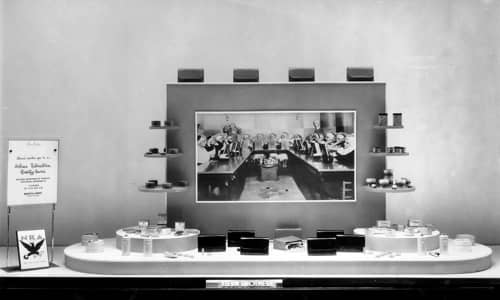
Above: c.1933 Stern Brothers department store window advertising the Helena Rubinstein School of Beauty on the second floor.
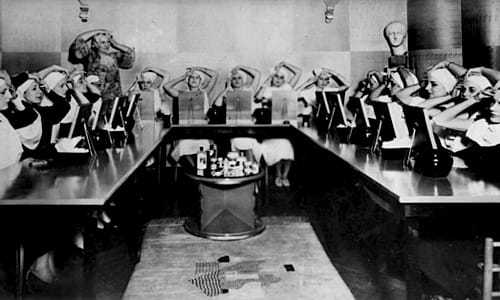
Above: c.1933 Helena Rubinstein School of Beauty class.
The American business also underwent substantial restructuring, culminating in a recapitalisation approved by the board in 1936. Things slowly improved but net profits did not return to 1920s levels until the 1940s.
Rubinstein’s interests in Britain and Europe do not appear to have suffered to the same extent as those in the United States but these markets were smaller and centred on the upper end of the cosmetic market which was less likely to be affected by the economic downturn.
Helena Rubinstein (London) Ltd. had been established by 1929 with the salon at 24 Grafton Street refurbished in 1928. Unfortunately, I don’t have any records of where Helena Rubinstein manufactured her cosmetics in Britain.
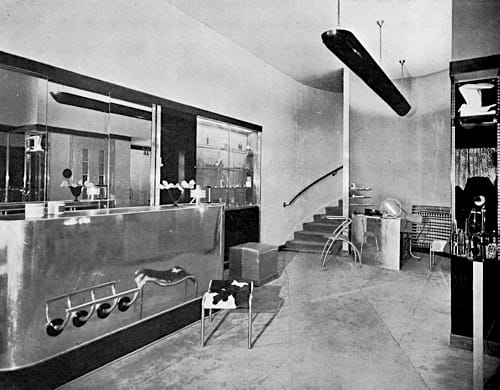
Above: 1934 Helena Rubinstein salon in London.
Rubinstein had created the Établissements Helena Rubinstein in Paris (capital ₣1 million) in 1929. She was the majority shareholder but small portions of the company were allotted to her two sons as well as her sister Stella who ran the Paris salon.
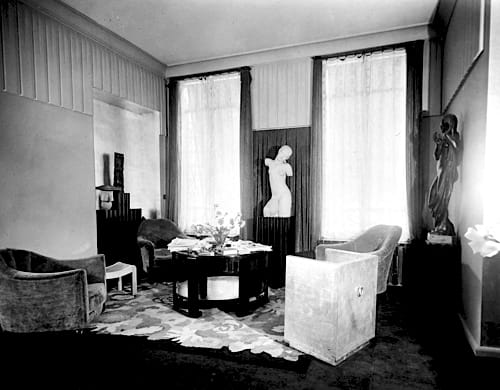
Above: 1935 Helena Rubinstein salon in Paris.
Manufacturing in France in the 1930s continued to operate at the factory in St. Cloud.
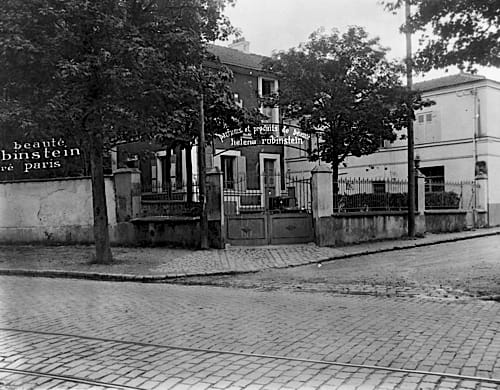
Above: 1935 Parfums et Produits de Beauté Helena Rubinstein.
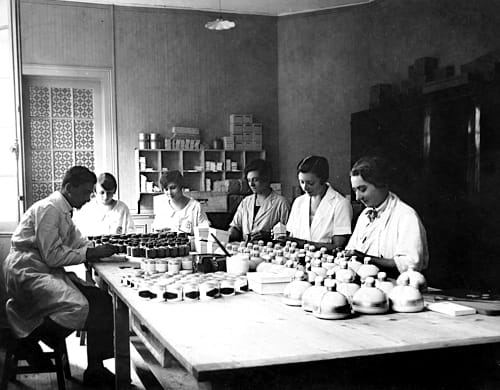
Above: 1935 Labeling cosmetics in the factory at St. Cloud.
Brand image
Lehman Brothers had focussed the company brand around the image of Helena Rubinstein rather than Valaze, a strategy Rubinstein continued after she regained control of the company. The Valaze brand was used more prominently outside of North America in the 1930s but its use there gradually declined as well.
Using the image of Helena Rubinstein to identify the brand had one major issue. By 1932, Rubinstein was in her sixties and no longer had the flawless skin and slim figure that had helped establish her business. To get around this problem, publicity photographs of her were ‘doctored’ to make her appear middle-aged.
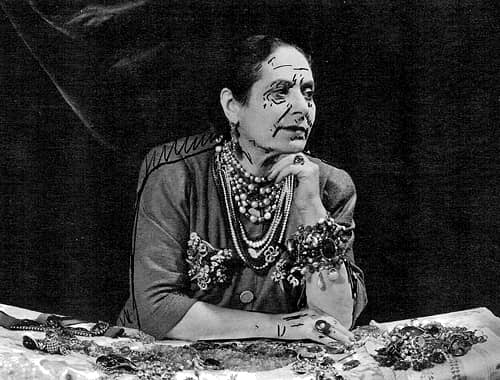
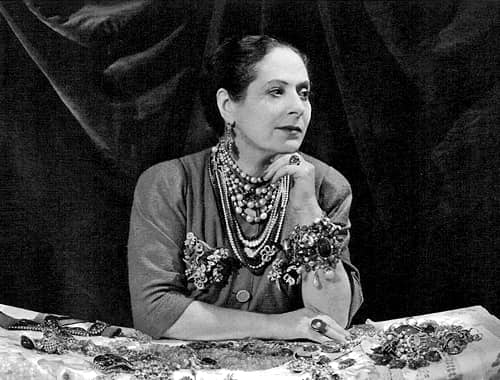
Above: 1932 Helena Rubinstein photograph by Cecil Beaton [1904-1980] for Vanity Fair showing how the published photographs were altered to remove age lines and excess flesh. Images of Rubinstein used in advertising were usually in profile, perhaps because they were easier to doctor.
Appearing in the flesh was another matter. Rubinstein’s tour of Australia in 1957 did considerable damage to the brand there when women saw Madame in person and discovered how aged she looked.
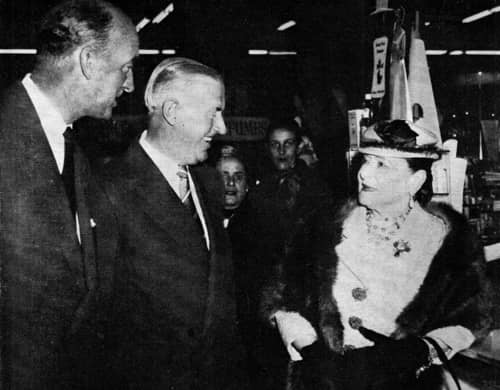
Above: 1957 Helena Rubinstein with Mr. Pettigrew and Mr. Hunt of the Myer Emporium, Melbourne during her Australia tour.
Fortunately, there were younger ‘Rubinsteins’ to take over most of the face-to-face interactions with the general public. In the United States this role was picked up by Helena’s niece Mala Kolin who renamed herself Mala Rubinstein.
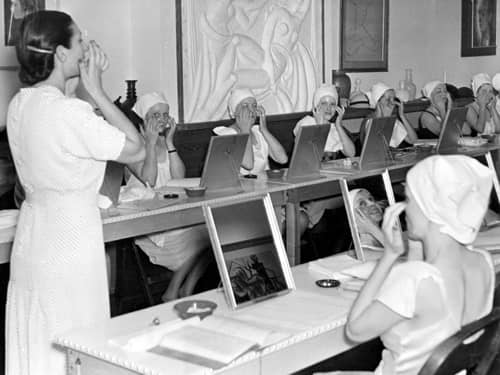
Above: 1937 Mala Rubinstein conducting a beauty class.
Salons
Rubinstein’s flagship salons gave her products an aura of exclusivity, elegance and culture and remained an important part of her business image between the wars. Women who could not afford a Rubinstein salon visit could indulge in its ‘luxuries’ by purchasing Rubinstein skin creams and make-up. Rubinstein reinforced this idea by suggesting that many of her products sold for use at home had once only been available to her exclusive salon clients.
LUXURIOUS SALON TREATMENTS
Adapted for your Home Use
After a journey or a long period out-of-doors and whenever the season changes—your skin needs a more intensive beauty treatment. Many of my European clients, and most of my English ones, make it a practice to devote one or two days a week to elaborate beauty care in addition to their regular treatments. For these women I have prepared the following rare home treatments of Oriental origin such as are given in my salons.(Rubinstein, 1937, p. 20)
To ensure that her products were used correctly Rubinstein – like most other cosmetic companies – provided her customers with detailed written instructions on how the products were to be applied and the company also answered letters from women about their particular beauty problems. However, Rubinstein went one step further, dispensing beauty tips through a series of ghost-written books – ‘The Art of Feminine Beauty’ (1930) and ‘This Way to Beauty’ (1936). The books included information on skin-care, hair-care and make-up but also had chapters devoted to exercise and diet. Rubinstein struggled with a weight-control problem for most of her life and she also published another book devoted to the subject, ‘Food for Beauty’, in 1938. However, when it came to her personal eating habits, she seems to have disregarded most of the advice it offered.
After Elizabeth Arden opened her new salon and gymnasium at 691 Fifth Avenue, New York, in 1930, Rubinstein became increasingly unhappy with the size and position of her salon on 57th Street. Consequently, she leased a seven-storey building at 715 Fifth Avenue and, after renovating the space, opened a larger, more luxurious salon there in 1936.
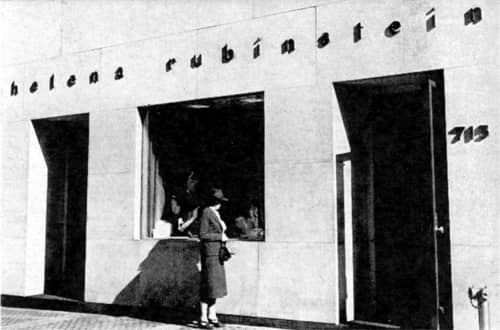
Above: Exterior of the salon at 715 Fifth Avenue, New York designed by Harold Sterner [1895-1976] and Samuel Oxhandler [1899-1894]. The Bauhaus-like signage rendered in lower case generated a lot of artistic interest and was used by Rubinstein in much of her subsequent advertising.
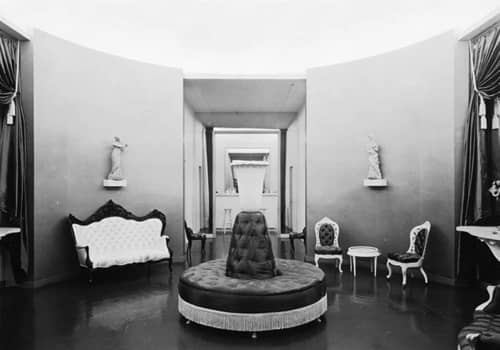
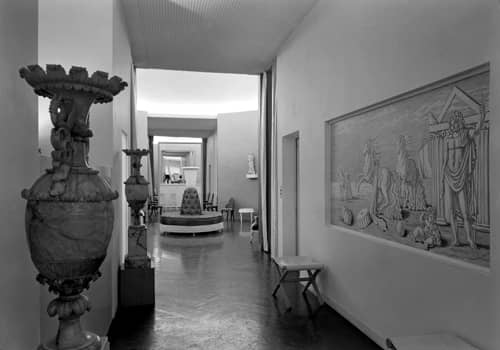
Above: Interior views of the salon at 715 Fifth Avenue designed by Ladislas Medgyes [1892-1952] and Mathilde Martine Kane [1893-1975]. Modernist lines were mixed with baroque elements, interspersed with pieces from Rubinstein’s art collection.
To generate publicity, Rubinstein opened the salon with an exhibition of miniature antique furniture from her private collection. Situated on the second floor, the exhibition was satirised in the 1939 movie ‘The Women’.
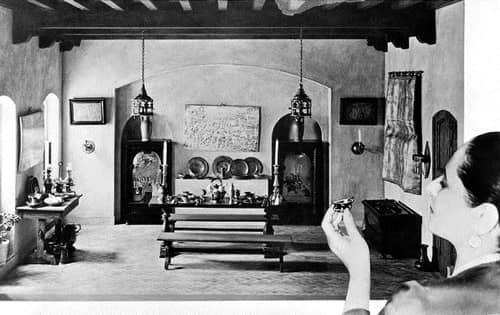
Above: Helena Rubinstein adjusting a miniature object in a diorama of an 18th century Spanish dining room.
See also: ‘The Women’ (1939)
The new salon offered a holistic approach to beauty developed according to ‘scientific principles’. Clients were provided with beauty-care facilities for their body, face and hair – beauty of form, beauty of face, and beauty of hair.
In my Salon, I require that my clients have a physical examination and a diet presented by a physician; and I suggest you do likewise. … Before you begin to decorate a house you clean and set it in order. Your body should be treated in the same manner.
(Rubinstein, 1936, p. 31)
Clients could book into the salon for individual treatments or, for US$25 and up, come for a full ‘Day of Beauty’ which included diet and exercise programs. The new salon was very successful and Rubinstein duplicated many of the facilities it offered in her Paris salon when it was upgraded in 1937.
See also: Rubinstein Day of Beauty
Salon treatments
As mentioned earlier, a number of Rubinstein salon treatments could be duplicated at home. Included amongst these were a range of facial masks; e.g., Herbal Mask, Pomade Noire, Pore Mask, Beautilift Mask and the Eastern Balsam Oil Treatment. However, some procedures required the use of specialised salon equipment.
Derma-lens: Known in some salons as the Dermascope, the device was used in initial consultations to show clients a magnified image of their face. By exposing their flaws it would help convince them of the need for an extensive treatment plan. First used in 1934, it was superseded by the Polaroid Skin Analyser that Rubinstein introduced in 1939.
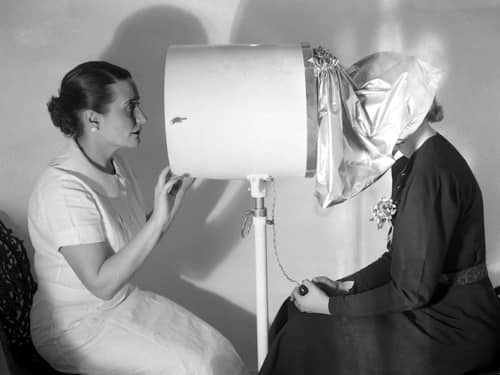
Above: 1937 Derma-Lens as used in Rubinstein’s New York salon.
See also: Complexion Analysers (Dermoscopes)
Oxylation treatment: This sprayed oxygen filtered through a herbal solution onto the skin which the skin could then ‘breathe in’. The equipment was similar to that used in a Carbonic Gas Spray but used oxygen instead of carbon dioxide.
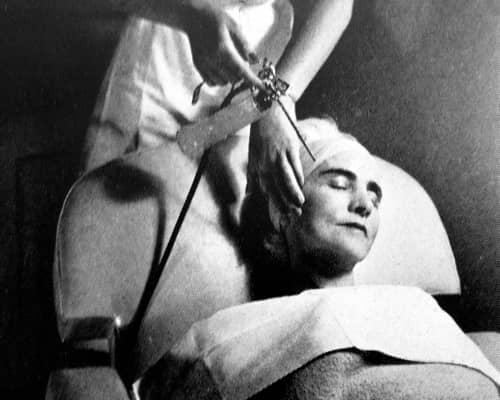
Above: 1938 Oxylation Treatment in a Rubinstein salon.
See also Carbonic Gas Sprays
Oxylation was generally employed as one step in a more extensive facial treatment; e.g., Dermal Cleansing.
Visit the salon for a Dermal Cleansing Treatment. By a unique combination of herbal vapour, light therapy (to stimulate circulation), inch-by-inch cleansing with a special extractor, masks and oxylation, your skin is freed of impurities, acid discolourations and open pores.
(Rubinstein advertisement, 1939)
Electro-tonic treatment: This used electricity to stimulate the circulation so that ‘flaccid tissue and muscles are rebuilt and made firm again’. This was supposed to firm the ‘underlying tissues that grow tired and sag and pull the skin out of place’. Rubinstein recommended it for any part of the face where lines or hollows might appear or to improve the contour of the throat and remove double chins.
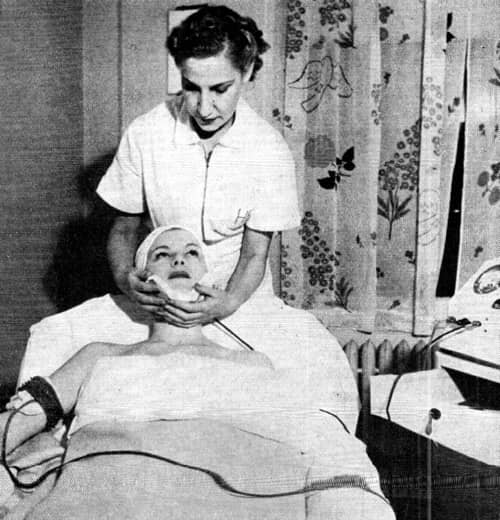
Above: 1939 Electro-tonic treatment in a Rubinstein salon. The pad was fixed in place with a rubber chin strap but the operator is also using her hands to ensure that good skin contact has been made.
Diathermy: The use of high-frequency electrical currents to warm facial tissues in beauty treatments had been pioneered by Elizabeth Arden with her Vienna Youth Mask (1928). A similar treatment was introduced by Helena Rubinstein as her Masque Monoval in her Paris salon in 1935.
See also: Arden Vienna Youth Mask
Rubinstein usually combined this diathermic mask with a cosmetic preparation so in the United States a salon diathermy treatment could be known by a variety of names; e.g., Hormone Heat Mask.
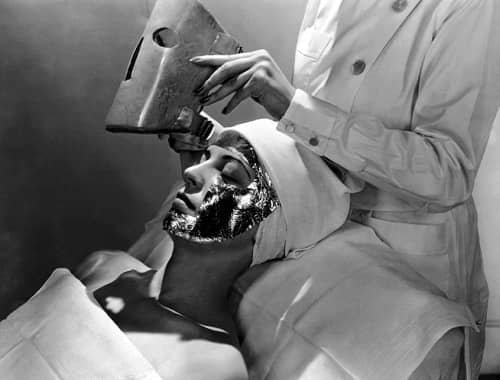
Above: 1934 Helena Rubinstein Hormone Heat Mask.
[T]he Hormone Heat Masque … gets to work on your skin in successive steps and layers. First there is the hormone cream, Madame Rubinstein’s first candidate for rejuvenation. Then, an electrode and over that a masque to shape it to your face are applied, and the heat action begins to force the cell stimulating cream down into your skin.
(Rubinstein advertorial, 1934)
Masques were frequently combined with other treatments such as a foam bath.
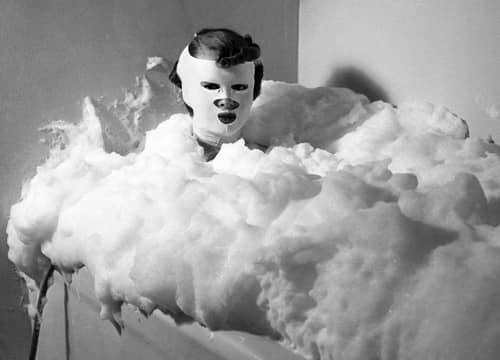
Above: 1937 Helena Rubinstein combined bath and mask treatment. Note the electrical cord running from the mask down the side of the bath.
As early as 1929, Rubinstein also used diathermy machines to permanently remove hair and treat telangetasia (small surface capillaries) in a process that we would now know as thermolysis.
Also see: Thermolysis and the Blend
San-O-Therm: During this treatment the client lay on a massage table covered with an electric blanket under a cabinet warmed with an infra-red heater. This was said to increase circulation, facilitate skin elimination (i.e., increase sweating), relieve pain and relax tense muscles and ligaments.
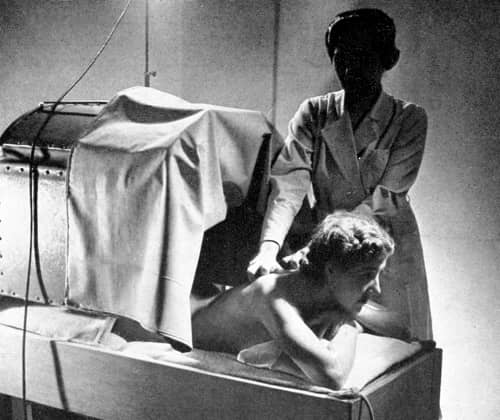
Above: 1937 The San-O-Therm treatment usually formed part of a weight-reduction program that included a vigorous reducing massage.
Paraffin wax treatments: Full-body paraffin wax treatments were carried out in Rubinstein salons and there were also paraffin wax treatments for the face, hands and feet. Full body treatments were generally employed to reduce weight while those used on the hands, feet and face were to help soften the skin and for spot reduction.
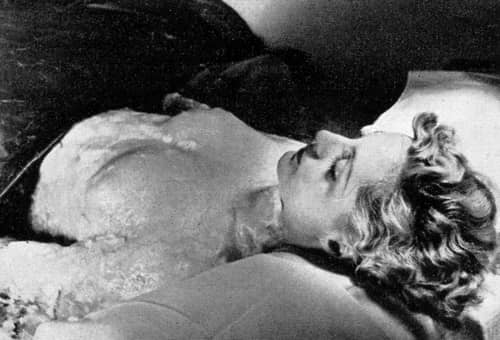
Above: 1937 Paraffin Wax Treatment.
See also: Paraffin Wax Treatments
Fragrances
Perfumes became more important to Rubinstein cosmetics in the 1930s. The company already produced higher-priced powders and other forms of make-up scented with Water Lily and Enchanté fragrances and before America entered the Second World War she added a number of new perfumes including Town (1936), Country (1936), Apple Blossom (1938), Flower Petal (1938), Gala Performance (1940), Heaven-Sent (1941) and White Fame (1942) As well as perfumes, eau de toilettes and eau de Colognes, these fragrances were used in make-up and skin-care cosmetics along with other products such as soaps, body sachets and deodorants.
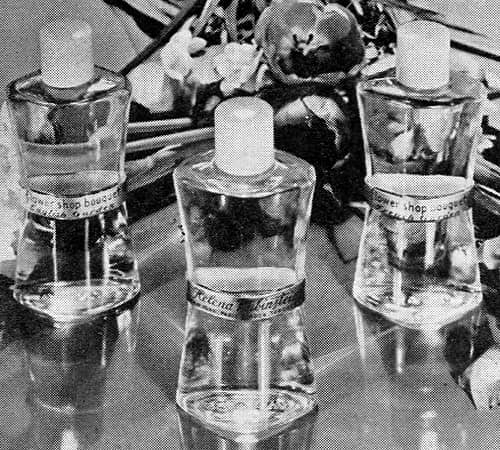
Above: 1938 Helena Rubinstein Flower Petal Eau de Colognes: English Garden, American Garden and French Garden.
Regulation
In the late 1930s, Rubinstein’s skin-care lines came under increasing government regulation In the United States. By 1936, Rubinstein, Inc. was receiving cease and desist notices from the Federal Trade Commission (FTC) concerning the advertising for many of its skin-care products which the commission claimed were “grossly exaggerated, false, misleading, and untrue”.
In truth and in fact, said preparations do not possess properties or contain ingredients that will feed or nourish the skin or lips, revitalize or restore youth to the skin, or prevent crows feet, wrinkles, or lines about the eyes. Said preparations do not contain hormones or living sparks of life which increase the therapeutic value of the products. Respondent’s “Marienbad Slenderizing Bath Salts” will not dissolve fatty tissues, nor are they effective weight reducers. Respondent’s “Eye Lotion” will not relieve eye strain or strengthen eye nerves. Respondent’s “Eyelash Grower and Darkener” will not grow or promote the growth of eyelashes in all cases, nor will respondent’s “Hormone Scalp Food” improve the growth and texture of the hair in all cases. Respondent’s “Youthful Herb Mask” does not contain the juices of 23 different herbs.
(‘Federal Trade Commission decisions’, 1939, p. 229)
Regulatory conditions in America tightened even further after the passing of the Food, Drug & Cosmetic Act (FD&CA) in 1938 and Rubinstein was forced to scale back many of her advertising claims there and rename some of her existing lines; e.g., Pore Mask was changed to Special Cream Mask and Herbal Eye Tissue Oil became Herbal Eyelid Oil. One of her oldest products got caught up in this process. The original Dr. Lykusky’s Russian Skinfood Valaze, known as Valaze Beautifying Skinfood by the 1920s, became Wake-up Cream after the use of the word ‘skinfood’ was deemed misleading by the FTC.
Skin-care
Most of the Rubinstein skin-care lines available in the 1920s were still being promoted in the 1930s. She continued to provided treatment plans for skin of different ages – 15-25, 25-40 and over 40 – and skin-care routines for different skin types – normal, oily and dry – now with the added ‘combination’ skin.
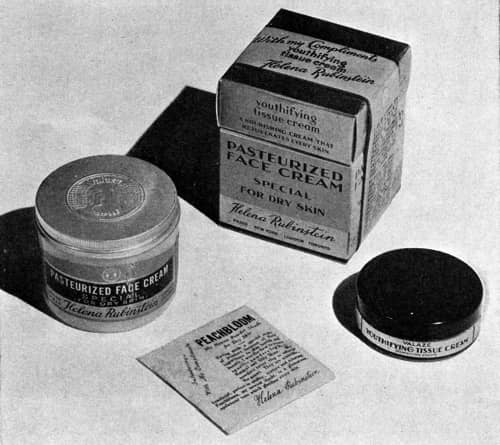
Above: 1933 Pasteurized Face Cream, Youthifying Tissue Cream and Peachbloom face powder sample.
Women coming to a Rubinstein salon or visiting a Rubinstein counter in a department store could have their skin analysed for free by a consultant who would then set up a treatment plan but Rubinstein also provided skin analysis and treatment information that women could use at home.
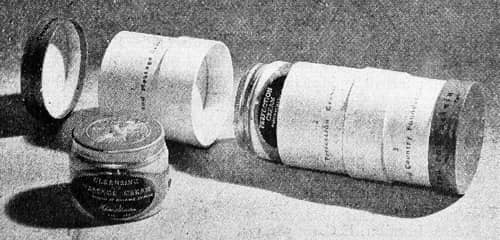
Above: 1938 Helena Rubinstein three step treatment pack: Cleansing and Massage Cream, Perfection Cream and Town and Country Foundation.
Rubinstein’s basic skin-care routines – cleansing, stimulating/animating, nourishing/lubricating, and then toning – remained much as before with skin stimulation still being important to women with more mature skins.
If I were to teach the importance of only one beauty practice, I should devote all my time to teaching the renewing power of skin stimulation. To enjoy the young, vital look of perfect skin, the blood must be dancing through your veins, and every tiny cell functioning actively. Stimulating the skin revitalises it, actually forces it to begin working for its own beauty. Sluggish circulation is quickened and impurities, blemishes, dullness and sallowness vanish from beneath the surface. The skin becomes more transparent, lovelier . . . at once.
(Rubinstein, c.1939, p. 11)
This idea goes right back to Rubinstein’s original Russian Skinfood Valaze which she noted was not a nourishing cream but rather a ‘stimulator of the skin’s activities’ (Rubinstein, c.1939, p. 12). Other Rubinstein skin stimulators, such as Eau Verte, Eau Qui Pique or Eau D’Or, had also been used by Rubinstein for many years.
No matter what skin stimulator was employed, Rubinstein considered that it would be more effective if combined with massage which ‘exercised muscles’ and ‘stimulated nerve endings’. To help clients applying products at home, Rubinstein provided detailed diagrams showing how to carry out the correct massage movements.
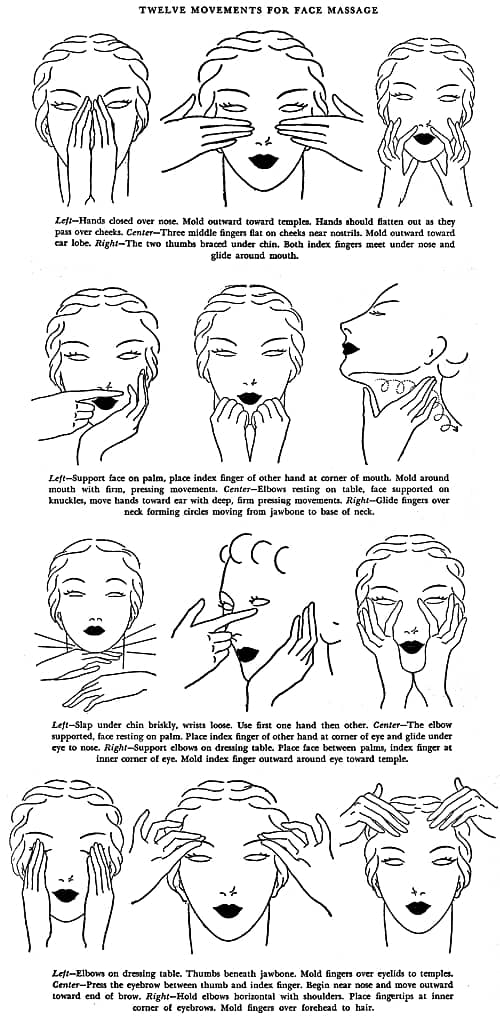
Above: 1936 Facial massage movements (Rubinstein, 1936, pp. 54-57).
Also see the company booklet: Beauty in the Making (1937)
Although skin stimulation was considered essential for revitalising mature skin, it was generally replaced by soothing or medicated preparations on younger, blemished skin.
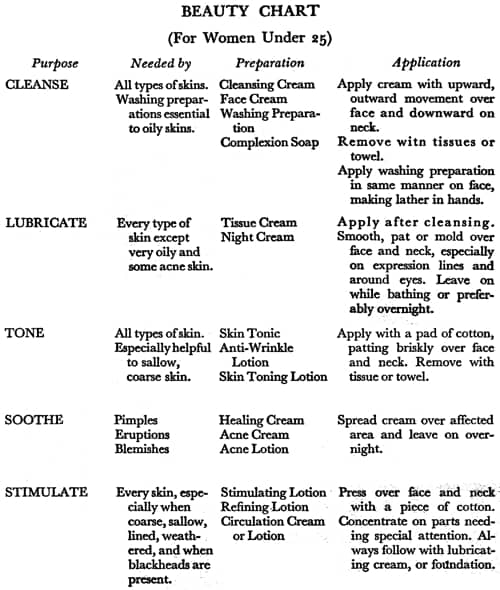
Above: 1936 Beauty Chart for women under 25 (Rubinstein, 1936, pp. 49-50).
Rubinstein’s other correctives for specific skin conditions – such as freckles, acne, wrinkles, puffy eyes and double chins – were much as before. She also continued to advise women on preventative treatments for each season but there was an increased emphasis on summer problems as more women engaged in the practice of suntanning.
New developments
During the 1930s some additional skin-care products were added to existing lines – e.g. Pasteurized Bleaching Cream and Pasteurized Milk Bath – and there were a number of new developments most of which seem to have had their origins in Europe.
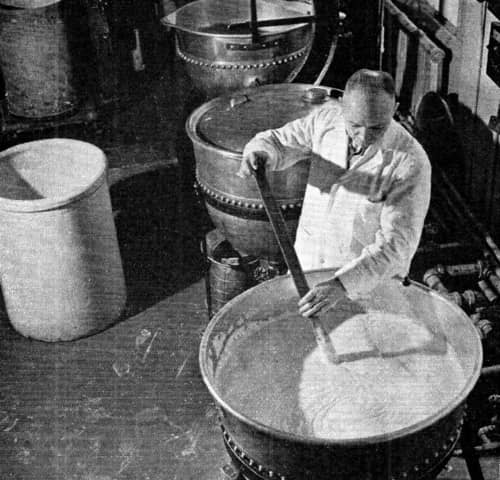
Above: 1939 Mixing Pasteurized Face Cream in the New York factory.
Herbal preparations
Rubinstein had included plant extracts from sources such as grapes, parsley, orange blossoms, water lily buds and lemons in her beauty preparations for many years but during the 1930s their use was emphasised with the addition of a number of skin-care cosmetics specifically marked as herbal. Amongst these were Herbal (Youthifying) Mask (1932); Herbal Cleansing Cream and Herbal Muscle Oil (1934); and Herbal Hair Remover, Herbal Hand Balm, Herbal Eye Tissue Oil and Herbal Skin Tonic (1935). The Herbal Muscle Oil is of particular interest as it appears to be Rubinstein’s first skin-care product that highlighted the use of vitamins.
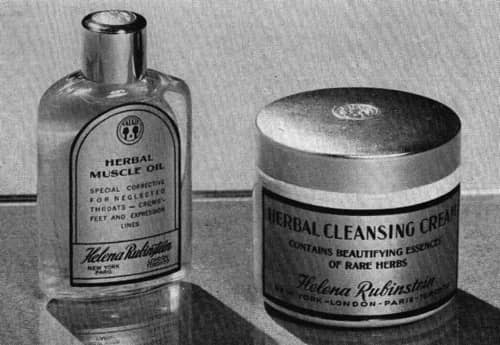
Above: 1934 Helena Rubinstein Herbal Muscle Oil and Herbal Cleansing Cream.
Herbal Cleansing Cream: “Its cleansing powers alone would insure its fame! But in addition, it infuses the tissues with renewed vitality.”
Herbal Muscle Oil: “Designed to offset the effects of modern living—modern dieting. … [R]eplaces in the skin primary vitamins and tonic elements. Its effect on ageing throats and lined, weary eyes is a complete revelation”
Herbal Skin Tonic: “[T]he perfect summer astringent. Cools. Soothes. Braces. Carry this crystal-clear tonic with you everywhere.A grand, quick cleanser for dusty summer journeys. It leaves your skin fresh and satin-smooth. Closes pores.”
Herbal Hand Balm: “A penetrating cleanser and skin softener in one. It is creamy soft, non-sticky and non-greasy. You use it as a one-minute hand shampoo for cleansing during the day.”
Herbal Hair Remover: “Applied with a spatula then covered with a flannelette strip, rubbed and pulled off.”
The emphasis on the herbs probably stemmed from France where plant extracts were held in high esteem. Unfortunately, Rubinstein’s tendency for exaggeration meant that some of them they got her into difficulties with the American authorities, a subject I will cover further on.
Hormone extracts
In 1931, Rubinstein introduced the Hormone Twin Youthifiers into the United States and then followed this with Hormone Beauty Masque (1934), Hormone Throat Balsam and Hormone Scalp Food.
Hormone Twin Youthifiers: “Two recently discovered creams that give back to your skin what the years steal away. The Hormone Twins act chemically to stimulate skin metabolism, building up aged, wrinkled, tired tissues and restoring the buoyancy of youth to glands and muscles of the face.”
Hormone Beauty Masque: “To experience this unique beauty creation is to enjoy the almost miraculous in new beauty! It absorbs all lines and drabness from the skin, all weariness from contours. Brings new loveliness, vitality. The greatest triumph of beauty science in years!”
The Hormone Twin Youthifiers consisted of a day cream (Twin 1) and a night cream (Twin 2). Rubinstein described them as ‘biological creams’ that contained ‘glandular rejuvenating essences’. However, only the Night Cream appears to have contained hormones. It is possible that the hormone was oestrogenic but its composition is unconfirmed and the ‘rejuvenating essence’ may have been some other biological material that was not truely hormonal in nature.
Also see: Hormone Creams, Oils and Serums
Rubinstein’s first confirmed oestrogenic cosmetic was Gourielli Estrolar Cream, released in 1942.
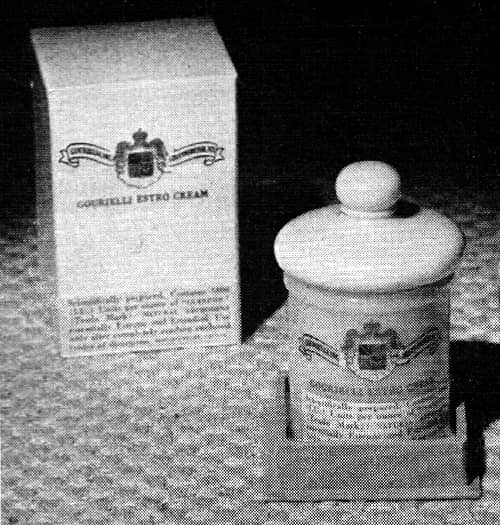
Above: 1942 Gourielli Estrolar Cream.
Masks
Rubinstein added a number of masks into her salon treatments during the decade. Those that did not require specialised equipment were generally made available as home treatments.
To the existing Grecian Contour Mask (1930) and Water Lily Rejuvenating Mask (1930) and the previously mentioned Hormone Beauty Masque (1934), Rubinstein added the Herbal (Youthifying) Mask (1932), and the Eastern Balsam Oil Treatment (1937).
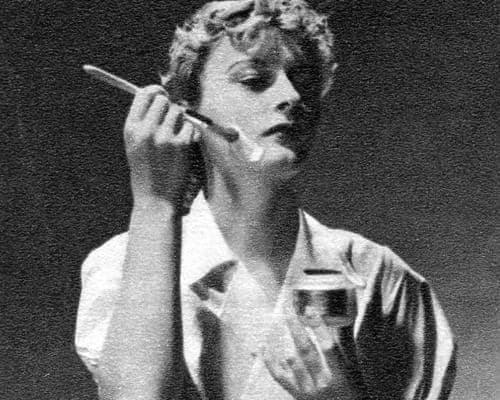
Above: 1935 Hormone Mask.
Hormone Beauty Mask: “It absorbs all lines and drabness from the skin, all weariness from contours. Brings a new-born look of loveliness and vitality—thrilling radiance. A triumph of modern beauty science.”
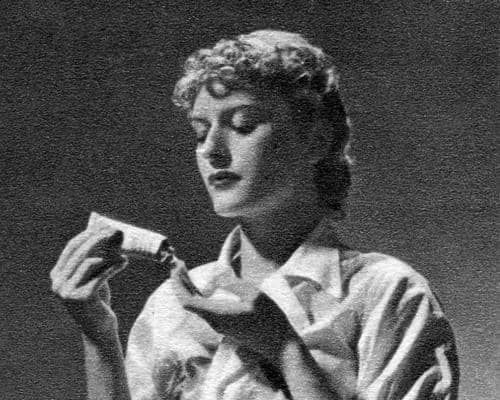
Above: 1935 Herbal Mask.
Herbal Mask: “Essences of 23 different youthifying and beautifying herbs make up this tonic, reviving mask. … [S]timulates fatigued, drab-looking skin to a new glow and radiance, tightens blurred contours into the clear-cut lines of youth and leaves the skin looking refreshed and blooming.”
Eastern Balsam Oil Treatment: “[A] blend of rare youthifying oils which effect a complete transformation of the skin. Starved, dormant, relaxed tissues eagerly absorb this rich nutrient. … Lines and wrinkles are smoothed away. Contours assume the firm rounded curves of youth.”
As well as these cosmetic masks, Rubinstein also introduced the Beautilift Masque (1937). Made from pink silk it was supposed to be dipped into Beautilift Lotion before being strapped on.
Beautilift Mask: “Made of specially treated pink silk, it is scientifically designed to the basic muscle structure of the face and throat. Dip it for the moment in the youthifying, tightening Beautilift Lotion and it is ready to be fitted on.”
Women could also purchase a Pomade Noire Mask or a Pore Mask. Although these were sold as new products they may have been developed from older lines. Pomade Noire probably used the existing Pomade Noire preparation while the Pore Mask may have been based on Rubinstein’s Blackhead and Open Pore Paste.
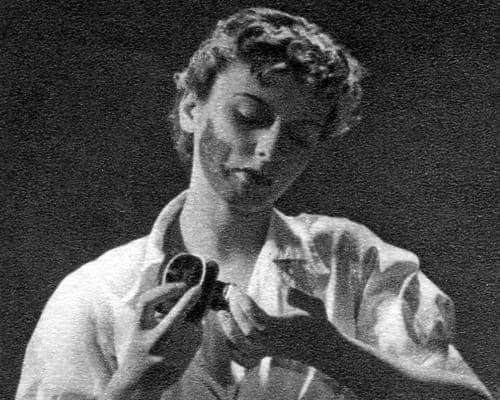
Above: 1935 Pomade Noire.
Pomade Noire: “[R]enews the skin by means of a gradual and imperceptible skin-peeling process. Acne pits and scars, and obstinate blackheads soon disappear. Drab, lifeless skin dulled by long neglect or ill health becomes fresh and radiant again.”
Pore Mask: “The only mask that can be massaged in. It literally renews your skin—refines and closes pores, banishes blackheads whiteheads and roughened skin surfaces. Overcomes excess oiliness and that drab sallow look. It gradually clears away acne scars and leaves the skin fine-textured radiantly clear.”
In 1939, Rubinstein added a foot mask with a paraffin wax treatment called a Foot and Ankle Masque and then did something similar for the hands with her Fingertip Masque (1940).
Foot and Ankle Masque: “[M]akes you feel as if you’d been paddling your feet in a mint frappé! … Draws out the aches, makes feet and limbs feel cool, supple, resilient for days afterward.”
Fingertip Masque: “[A]n emerald liquid which must be heated and each fingertip dipped in the warm liquid to the first joint. As each finger is taken out, the waxy coating forms a little jacket around the finger and nail. It should remain on the fingertips for ten minutes or so and the wax masque then peels off at a touch and the rough, horny skin at the nail corners has been reconditioned.”
Night Creams
In 1936, Rubinstein added Novena Night Cream into her range. Made with a base containing the oils used in the Eastern Oil Treatment, Novena Night Cream was designed for dry, lined skin. Other products specifically sold as night creams in this period included Hormone Night Cream, one of the Hormone Twin Youthifiers, and Town and Country Night Cream. The later was actually Youthifying Tissue Cream (1931) that had been renamed due to the provisions of the 1938 Food, Drug & Cosmetic Act.
Novena Night Cream: “During the hours of sleep when your body is rebuilding itself, Novena Night Cream builds new beauty deep in your skin. Fresh vitality stirs in the tissues. Gone is the look of weariness and strain. Your face regains that smooth, lush look.”
Make-up
By 1930, Rubinstein was selling a complete range of make-up in limited but serviceable shade ranges. Through the 1930s she introduced new colours which, by 1936, were organised by a ‘Three-Point’ system. This matched face powder with a woman’s complexion, eye make-up with her eye colour, and rouge and lipstick with the clothing she wore.
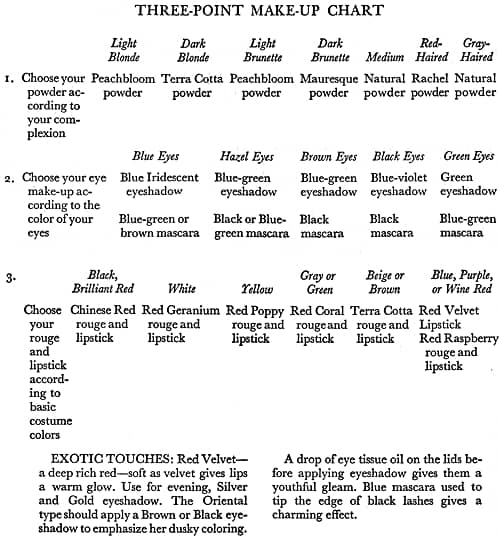
Above: 1939 Three-Point Make-up Chart. Rubinstein added suggestions for grey eyes in later charts.
Also see the company booklet: Beauty in the Making (1937)
As with her skin-care products, Rubinstein continued to emphasise the use of make-up to express a woman’s individuality. In the late 1920s and early 1930s Rubinstein promoted this idea through her ‘Personality Make-up’. In 1935, this was followed by the ’Your Cosmetic Portrait’ promotion which explained how to use make-up to contour the face closer to an ideal.
What shape is your face—Oval, Round, Long, Heart-Shaped? Learn to model it with cosmetics, nearer your ideal.
Helena Rubinstein shows you how to dramatise your charm, stage your individuality, express the real YOU. A fascinating method of personal cosmetic styling you simply must know! Helena Rubinstein’s colorful new folio “Your Cosmetic Portrait” explains it.(Rubinstein advertisement, 1935)
Contouring had long been used in theatrical and film make-up and was heavily publicised by Hollywood cosmetics firms such as the Westmores. It was yet another example of individuality expressed through conforming to a type.
See also: Make-up, Personality and Types
Beginning in 1938, Rubinstein began introducing complete lines of colour-coordinated make-up, with new forms coming out each year. For example, her Orchid and Champagne make-up range (1938) consisted of Orchid Red Lipstick and Rouge, Orchid Eye Shadow, Deep Orchid Mascara, Orchid Red Nail Groom, and Champagne Rose Face Powder. Other coordinated ranges were Aquarelle (1938), Rose Tan (1938), Opaline (1939) and Rico Tan (1940).
Face powders
In 1930, Rubinstein sold three main face powders: Valaze, Water Lily and Enchanté. The Valaze powders, either Complexion for normal or oily skin, or Novena for dry skin, came in White, Cream, Natural, Rachel, Blush, Mauresque, Ochre, French Ochre, Gypsy Tan and Dixie Tan shades. As Valaze was depreciated the two powders became known simply as Novena and Complexion.
New powder colours were added during the decade including: Ivory Rachel (1932), Peachbloom (1932), Terracotta (1935), Terra Cotta-light (1936), Riviera Tan (1937), and Champagne Rose and Bisque (1938). The darker shades reflected an increased level of suntanning and were often used in powders described as Sunproof, a ‘heavier’ powder that may have contained larger amounts of zinc oxide and/or titanium dioxide.
Gypsy Tan Sunproof Powder which gives your skin a beautiful red-brown appearance that reminds you of the sun’s after-glow. Yet this Gypsy Tan Make-Up contains ingredients which counteract the ageing actinic sunrays. It’s a marvelous summer make-up.
(Rubinstein advertisement, 1932)
Rubinstein also described a number of her powders as Weatherproof. These may have also have been ‘heavier’ powders but coloured with lighter shades such as Natural, Rachel, and Peaches and Cream.
In 1938, Rubinstein added Town and Country Face Powder in Peachbloom, Rachel, Mauresque and Bisque shades. The powder was ‘moisture-proofed’ (‘balsamized’) and ‘pre-expanded’, processes that were said to prevent the powder from drying the skin and enlarging the pores.
It is feathery-fine, clings longer, and actually works as a beauty treatment all the time it is on your skin. Helena Rubinstein’s new face powder is pre-expanded before it touches your skin—completely expanded by saturation so that it will not enlarge the pores. It’s balsamized—coated with a fine film of rare balsam so that it cannot rob the skin of its natural moisture. And will not dry the most sensitive skin.
(Rubinstein advertisement, 1938)
It is possible that these moisture-proofed powders came out of research into baby powder. Diaper rash was a common problem in babies and ‘balsamized’ talcum powder may have been a useful preventative. In 1937, Rubinstein released a line of infant cosmetics, a year before she introduced her moisture-proof face powders, which, along with Town and Country Face Powder, also included Water Lily Face Powder and Flower Petal Face Powders. Aquacade (1940) was also moisture-proofed.
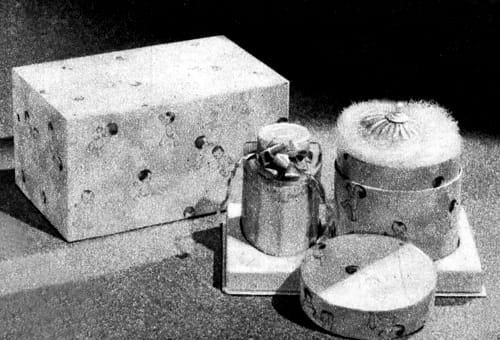
Above: 1937 Helena Rubinstein boxed set containing Baby Edition Pasteurized Milk Bath and Baby Powder.
Flower Petal Face Powder (moisture-proof): “Helena Rubinstein’s flattering new powder is actually a beauty treatment for dry, lined, wrinkled skin. It works for your beauty all the time it is on your face—protects the fine texture of your skin, and brings out all its loveliness and beauty.”
Foundations
By 1930, Rubinstein had a bewildering number of cosmetics – creams, lotions and oils – listed as possible foundations. All could be used as a base for face powder but some were primarily designed to be protective rather than just beautifying.
Valaze Cream of Lilies: “[A] pearly liquid cream … suitable for every age and type of skin—a lovely makeup base.” Shades: Ivory.
Water Lily Foundation: “[A]n exquisite semi-liquid cream.” Shades: Rachel.
Balm Rose: “[F]or the conservative woman and the sportswoman. soothes and protects the skin, prevents or corrects chapping, gives a natural finish.”
Snow Lotion: “[A] liquid powder foundation for all skins.” Shades: White, Rachel, Natural and Cream.
Sun and Windproof Cream: “A very protective foundation for sports women. Easy to apply. Quite imperceptible.”
Sunproof Lotion: “[A] most becoming liquid powder that gives great delicacy to the complexion, and yet protects it from exposure.” Shades: Cream, Natural and Rachel.
Youthifying (Beauty) Foundation Cream: “Prevents sunburn and freckles. Gives a loverly, smooth, youthful finish.”
Crème Gypsy/Gypsy Tan: “[G]ives a tan effect but protects the skin against freckles, sunburn and real tan. A very adherent foundation, suitable for blondes and brunettes.”
Huile Gypsy: “A smooth, fine, protective oil that gives the effect of a golden tan. Suitable for back and limbs. Most adherent.”
New foundations introduced during the 1930s included: Water Lily Snow Lotion (1934), which I assume was simply the original Snow Lotion with an added Water Lily fragrance; and Town and Country Make-up Film (1935), a cream foundation sold in France as Crème Ville et Sport that was said to be protective against sun and wind burn. A twin product Town and Country Make-up Lotion was introduced in 1936.
In 1939, Rubinstein released Photochrome Foundation, a creamy lotion designed to cover ‘blemishes, crow’s feet and other lines revealed by the camera’. Sold in numbered shades – e.g. Photochrome No. 1, Photochrome No. 2 – the product may have been produced in response to Elizabeth Arden’s Screen and Stage Make-up (1935). After its initial release it received little promotion and seems to have been discontinued during the Second World War. By this time Rubinstein had introduced Conceal (1942), a concealer in light and dark shades that could be used to covering up moles, freckles and other skin blemishes.
See also: Arden Screen and Stage Make-up
Lipsticks and rouge
In 1930, Rubinstein had three lipsticks in her range: Valaze, Cubist and Water Lily. In 1931, the company added an Automatic Lipstick for sports, which it updated in red, black and green cases in 1933.
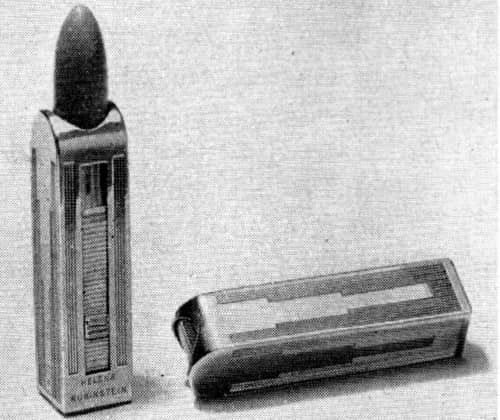
Above: 1931 Helena Rubinstein Automatic Lipstick.
The following year saw the release of a Water Lily version of the Automatic Lipstick, followed by: Golden Automatic (1935); Water Lily Grande lipsticks (1935) in satin-striped, gold-toned cases; and Town and Country lipsticks (1936). There was also Lipstick Plus (1939), a jumbo-sized lipstick which could be refilled, a process made easier by giving each refill its own metal base.
Rubinstein added a number of new lipstick shades through the decade, each matched with rouge. Starting with Red Geranium, Red Raspberry (Light, Medium or Dark), Red Ruby, Red Cardinal and Red Tangerine in 1930, new shades added up to 1940 included: Coral/Red Coral (1931), Red Poppy (1933), Evening (1934), Terra Cotta (1935), Terra Cotta-Light and Chinese Red/Mandarine (1936), Velvet Red (1937), Orchid Red and Aquarelle (1938), Sporting Pink (1939), and Life Red, Rico Red and Night Red (1940). Some shades were not available in all lipstick types; e.g., in 1930, Valaze Lipstick was produced in Red Geranium and Light, Medium or Dark Red Raspberry shades but Cubist Lipstick was only available in Red Geranium and Light or Medium Red Raspberry.
Rubinstein also developed new case designs in a variety of colours so that women could match them with clothing or other accessories; e.g., Valaze Chatelain (Chain) Lipsticks (1931) and Costume Lipsticks (1937).
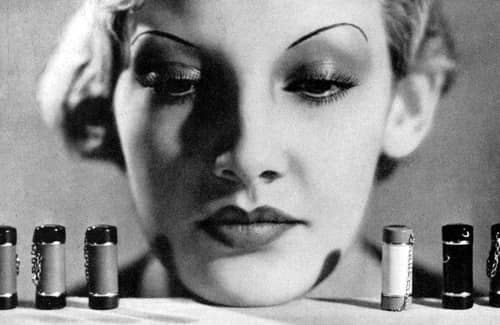
Above: Valaze Chatelain (Chain) Lipsticks with caps attached to the body of the lipstick case with a chain.
Lipsticks shades were only matched with rouge until Rubinstein began introducing coordinated make-up ranges in 1938. After this she generally colour coordinated her lipsticks with both nail polish and rouge.
Eye make-up
Rubinstein had introduced eyeshadows into her make-up range back in 1925. In 1931, she added Iridescent Eye Shadow in Blue, Green, Blue-Green, and Violet-Gold shades, followed by Grey in 1932. Most of these were silver in tone suggesting that fish scales or bismuth oxychloride was used.
See also: Pearl Essence
In 1935, Rubinstein added a new ingredient to her Persian Mascara to encourage the growth of lashes, possibly lanolin. Shades: Black, Brown, Chatain, Blue, Green. Other eye make-up remained much the same through the decade and she continued to sell skin-care creams and lotions specifically for the area around the eyes.
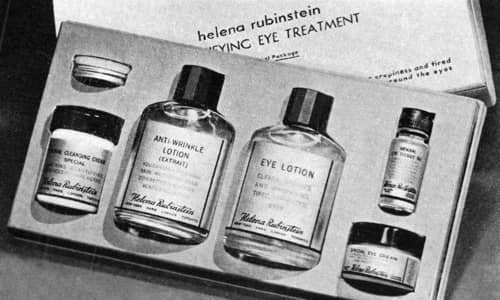
Above: 1936 Rubinstein Rejuvenating Eye Treatment Pack: Eyelash Grower, Herbal Cleansing Cream (Special), Anti-Wrinkle Lotion (Extrait), Eye Lotion, Herbal Eye Tissue Oil and Special Eye Cream.
Nail cosmetics
In 1930, Rubinstein’s nail polish, Nail Groom, only came in Shell Pink, Red Geranium and Red Raspberry shades. Coral was added in 1931 but there do not appear to have been any additions to the Nail Groom colour range until Rubinstein added Orchid Red, and Aquarelle (1938), and Sporting Pink (1939), the first shades Rubinstein produced that were colour coordinated with lipstick and rouge.
Coordinating lipstick and nail polish shades was a French trend that later extended to the American market. Cutex had introduced a line of lipsticks to match its Crème Nail Polish in 1934 and Revlon would introduced lipsticks with matching nail polishes in 1939.
Gourielli
In January, 1938, Rubinstein divorced Titus and was then free to marry Prince Artchil Gourielli-Tchkonia in Paris in June. Despite the fact that his title was suspect, Helena was happy to think of herself as a princess.
The newlyweds honeymooned in South America but Rubinstein combined business with romance during the trip. She bought South American art and checked out new markets for her products ultimately opening salons in Buenos Aires, Rio de Janeiro and San Paolo. In this instance she was behind Elizabeth Arden who had established Elizabeth Arden (South America) Inc. in 1935 and already had operations running in Brazil and Argentina.
See also: Elizabeth Arden (1930-1945)
In 1941, Rubinstein put her new name and title to good use, releasing the Prince Gourielli line for men and the Princess Gourielli line for women. The products were kept separate from her other lines and sold out of an ‘Apothecary Shop’ created in a brownstone building at 16 East 55th Street, New York, and through the usual department and drug stores.
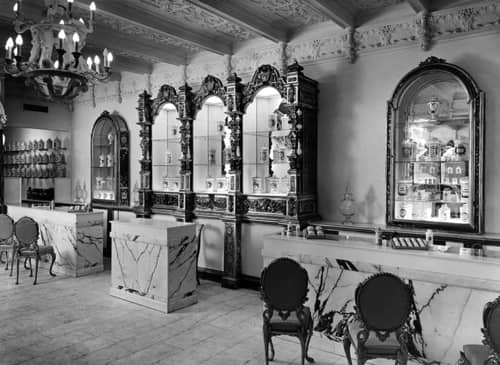
Above: 1941 Gourielli Apothecary Shop fitted out in real and faux marble. In typical Rubinstein fashion she also decorated it with some of her art collection including American and Mexican primitives and a few Picassos.
Artchil knew very little about manufacturing cosmetics but dutifully posed for the obligatory ‘mixing products in a laboratory’ – photographs that Rubinstein loved.
World’s Fair and waterproof mascara
According to legend it was during the 1939 New York World’s Fair when Rubinstein introduced her Waterproof Mascara in Black, Brown, and Blue shades. The mascara was supposedly developed for the Aquabelles performing in the Aquacade.
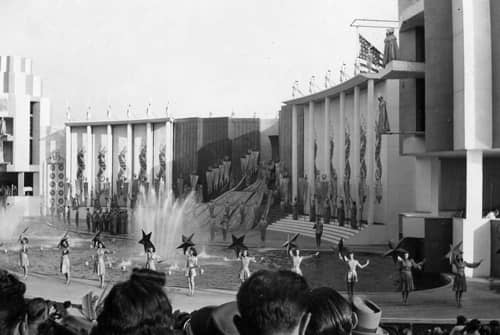
Above: 1939 The Aquacade at the New York World’s Fair. The show was first produced by Billy Rose (William Samuel Rosenberg [1899-1966]) at the Great Lakes Exposition in 1937.
This strikes me as very dubious. O’Higgins mentions Rubinstein visiting the ‘Mascara Countess’ in Vienna, whom, I assume, was Helene Vierthaler Winterstein [1900-1966] the inventor of the first waterproof mascara.
Our next few days in Vienna had a surrealistic quality due to the unexpected succession of events.
Madame flitted around the occupied city with the energy of a halloween witch. She held secret meetings with “The Mascara Countess,” visited shops stocking Rubinstein merchandise, and finally presided over a mammoth press conference.(O’Higgins, 1971, p. 156)
It therefore seems more likely that Rubinstein licensed the waterproof mascara from Winterstein and used the Aquacade as a publicity stunt to launch the product in the United States. The mascara was only one item in the Aquacade range (1940) which included: Aquacade Foundation Cream or Lotion and Aquacade Compressed Face Powder, both in Light and Dark shades; Aquacade Indelible Lipstick; and Aquacade Hair Lotion.
Wear it on land or sea as do the glamorous Aquabelles of the World's Fair Aquacade. Powder, mascara, lipstick—all of it stays on hour after hour in the water or out.
(Rubinstein advertisement, 1940)
Rubinstein later downplayed the waterproof claims for many of the products. The powder was dropped from advertisements and other products were described as water-resistant rather than waterproof.
Wartime
By 1939, Helena Rubinstein’s global business was beginning to get back to normal. Her products were being sold through about 6000 outlets including ten American salons – New York, Boston, Philadelphia, Detroit, Newport, Newark, Chicago, Los Angeles, San Francisco and Seattle – and seventeen salons around the world – London, Paris, Copenhagen, Brussels, Vienna, Milan, Rome, Cannes, Nice, Monte Carlo, Madrid, Buenos Aires, Toronto, Honolulu, Melbourne, Sydney, and Johannesburg – supplied from five factories – Long Island City (New York), London, St. Cloud (Paris), Milan, and Melbourne (AP&EOR, 1939).
Unfortunately, these improved business conditions were disrupted by the outbreak of war in Europe in September, 1939. Helena managed to get most of her relatives out of Europe – sister Stella was sent to Argentina, great-niece Regina went from Vienna to Australia and sister Ceśka moved from London to New York – but her sister Regina remained and would later perish in a concentration camp. The Rubinstein salons in Berlin, Vienna and Paris were lost but much of her property in Paris escaped confiscation as Helena had transferred ownership to her French lawyers (Woodhead, 2003, pp. 254-255), so technically it was not regarded as Jewish by the German occupying forces.
America did not enter the war until December, 1941. In 1942, Rubinstein, Inc. got a financial boost when it secured a contract to provided kits which included camouflage and sunburn creams for the American army (Woodhead, 2003, p. 274). They were used in ‘Operation Torch’, the invasion of North Africa in November, 1942.
Rubinstein released a number of new cosmetics after America entered the war including the stocking substitutes Leg Stick, Aquacade Leg Lotion and Gourielli Leg Tint (1942); and Minute Stocking Film (1944). The products were used in her Bare-Leg Bar opened in the Fifth Avenue salon in 1942.
See also: Cosmetic Stockings
Rubinstein also released Town and Country Filmpact in 1942, a cake make-up that was a response to Max Factor’s highly successful Pan-Cake Make-up (1938). Like Pan-Cake it was applied with a sponge but unlike Pan-Cake it came in two forms, one for dry skin and one for oily.
Town and Country Filmpact: “[T]he only cake makeup blended in 2 textures . . . for the dry skin, and for the oily skin. You smooth on Filmpact with a moistened sponge. It’s so quick . . so long lasting . . . stays fresh and flawless for hours without retouching.” Shades: Peachbloom, Mauresque, Rachel and Rico Suntan.
See also: Pan-Cake Make-up
In 1944, Rubinstein added Cream-Tint Foundation, a creamy cake make-up, a presage of a type of make-up that would become popular after the war.
Cream-Tint Foundation: “[T]he foundation that combines the lasting qualities of cake make-up with the protective softness of a cream base. A foundation that smooths your skin to a marvellously velvety texture—and imparts a glamorous all-over color to your complexion.” Shades: Peachbloom, Rachel, Mauresque, Plush Pink and Rico Suntan.
See also: Cake Make-up
New lipstick shades added after 1940 included Red Apple (1941), Cochinelle (1942) and Plush Red (1944). In Britain, Australia, and other Commonwealth countries there was also the patriotic Regimental Red (1939) which, as far as I can tell, was not available in the United States.
Surprisingly, given the increased demand for hand creams during the war, Rubinstein did not update her hand-care cosmetics until 1945 when she introduced her Herbal Hand Cream and Herbal Hand Lotion.
See also: Hand Balms, Creams & Lotions
One other development that deserves a mention is the Five-Day Wonder Course Rubinstein introduced in 1942. The stimulus for the course may have come from the popularity of the Richard Hudnut’s Du Barry Success Course which began in 1940.
See also: Du Barry Success Course
Although not as comprehensive as the Du Barry Success Course, Rubinstein’s Five-Day Wonder Course covered the basics – diet, skin-care and make-up.
Also the see the company booklets: Wonder Course: Beauty Primer (1949), Wonder Course: Make-Up Palette (1949), and Wonder Course: Diet Calendar (1949)
V-E Day
After the German High Command surrendered in May, 1945, Rubinstein booked passage to France as soon as she could, arriving in Paris in September before moving on to London by Christmas (Woodhead, 2003, p. 295). The salon and factory in Paris had been requisitioned by the Germans during the war but both were largely intact. The same cannot be said of London. The salon at 24 Grafton Street had been bombed and had moved to temporary, cramped accomodation at 45 Berkeley Square. Fortunately, Rubinstein managed to lease a suitable building at 3 Grafton Street and began plans to convert it into a salon.
Elsewhere in Europe things were even worse. Starting over would not be easy. Rubinstein was now in her middle seventies, and the business conditions of the time included currency restrictions, high taxation and material shortages. She was also coming under increasing pressure from younger, more energised competitors, like Charles Revson [1906-1975] of Revlon.
Timeline
| 1930 | New Products: Grecian Contour Mask; Water Lily Rejuvenating Mask; Water Lily Cleansing Lotion; Youthifying Stimulant; Youthifying Tissue Cream; Youthifying Hand Cream; and Enchanté Lipstick. |
| 1931 | Rubinstein regains control of the American business. New Products: Hormone Twin Youthifiers; Pasteurized Bleaching Cream; Automatic Lipstick; Valaze Chain Lipsticks; and Iridescent Eye Shadow. |
| 1932 | Salon opened at Kohlmarkt 8, Vienna. New Products: Herbal Mask. |
| 1934 | Helena Rubinstein Inc incorporates in Seattle and opens a salon there; Derma-Lens introduced. New Products: Herbal Cleansing Cream; Herbal Muscle Oil; Hormone Beauty Masque; Sunproof Cream; Enchanté Bath Essence; and Water Lily Automatic Lipstick. |
| 1935 | New Products: Herbal Hand Balm; Herbal Eye Tissue Oil, Herbal Skin Tonic; Herbal Hair Remover; Town and Country Make-up Film; and Golden Automatic and Water Lily Grande Lipsticks. |
| 1936 | New York salon moved to 715 Fifth Avenue. New Products: Novena Night Cream; Town and Country Make-up Lotion; and Town and Country Lipsticks. |
| 1937 | Paris salon refitted; Training school opened in the Fifth Avenue salon. New Products: Beautilift Masque; Eastern Balsam Oil Treatment; Anti-Sunburn Cream; Costume Lipsticks and Vanities; and Infant cosmetic line. |
| 1938 | New Products: Sunproof Cream; Town and Country Face Powder; and Flower Petal Face Powders |
| 1939 | Vienna salon closed; Polaroid Dermoscope Skin Analyser introduced. New Products: Foot and Ankle Masque; Photochrome; Lipstick Plus; Waterproof Mascara; Minute Make-up Compacts; and Pasteurized Milk Bath Powder. |
| 1940 | Sydney salon (House of Beauty) moved to 82 Castlereagh Street. New Products: Keys to Beauty lipsticks; Classic Lipsticks with Vitamin E; Fingertip Masque; and Water Lily Deodorant Lotion and Cream. |
| 1941 | Gourielli shop opened in New York. New Products: Prince Gourielli and Princess Gourielli lines; Apple Blossom Hand Lotion; Young Complexion Kit; and Town and Country Make-up Film Special. |
| 1942 | Introduces the Five-Day Wonder Course; and opens a Bare-Leg Bar in the Fifth Avenue salon. New Products: Leg Stick; Leg lotion; Town and Country Filmpact; Conceal; Gourielli Estrolar Cream; Gourielli Leg Tint; Gourielli Active Ozone Cream and Gourielli Shave Cream. |
| 1944 | New Products: Minute Stocking Film; and Cream-Tint Foundation; and Gourielli Sulfo-Colloidal Cream. |
| 1945 | New Products: Snow Lotion (Medicated); Herbal Hand Cream (night) and Herbal Hand Lotion (day). |
Continued onto: Helena Rubinstein (post 1945)
First Posted: 28th December 2017
Last Update: 17th April 2023
Sources
Fabe, M. (1972). Beauty millionaire. The life of Helena Rubinstein. New York: Thomas Y. Crowell Company.
Federal Trade Commission decisions: Findings, orders and stipulations. December 1, 1936, to May 31, 1937. (1939). Volume 24. Washington: Government Printing Office.
Helena Rubinstein. (1930). Beauty in the making [Booklet]. USA: Author.
Helena Rubinstein. (c.1931). Beauty for you [Booklet]. USA: Author.
Helena Rubinstein. (1937). Beauty in the Making [Booklet]. UK: Author.
Helena Rubinstein. (c.1939). Beauty for you [Booklet]. Australia: Author.
Helena Rubinstein. (1947). A new and lovelier you [Booklet]. USA: Author.
O’Higgins, P. (1971). Madame: An intimate biography of Helena Rubinstein. New York: The Viking Press.
Rubinstein, H. (1930). The art of feminine beauty. New York: Horace Liveright, Inc.
Rubinstein, H. (1965). My life for beauty. Sydney: The Bodley Head Ltd.
Slesin, S. (2003). Over the top: Helena Rubinstein extraordinary style, beauty, art, fashion design. New York: Pointed Leaf Press.
Woodhead, L. (2003). War paint. Miss Elizabeth Arden and madame Helena Rubinstein their lives, their times, their rivalry. London: Virago Press.
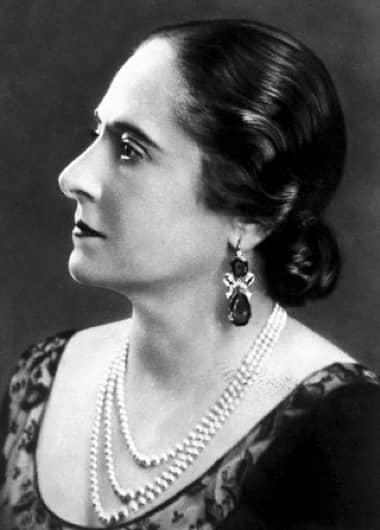
Helena Rubinstein [1871-1965].
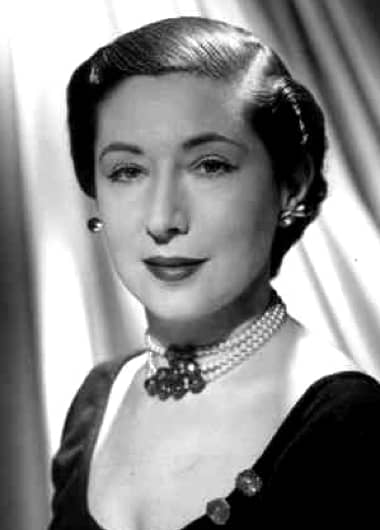
Mala Silson (née Kolin) [1905-1999] known professionally as Mala Rubinstein. She began working for Helena Rubinstein in Paris when she was 18 and by the time the company was sold to Colgate-Palmolive in 1973 she had become an executive vice president of the American company. Her brother Oscar Kolin [1908-1995] was chairman of the board of Helena Rubinstein, Inc. and its chief executive office.
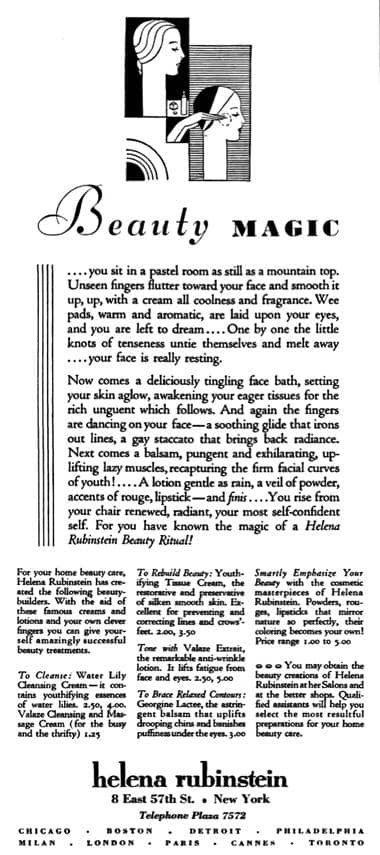
1930 Helena Rubinstein Beauty Magic.
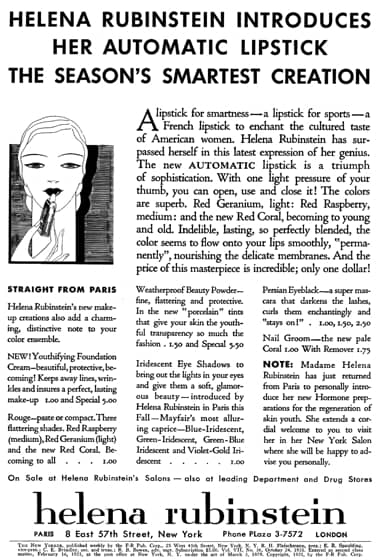
1931 Helena Rubinstein Automatic Lipstick.
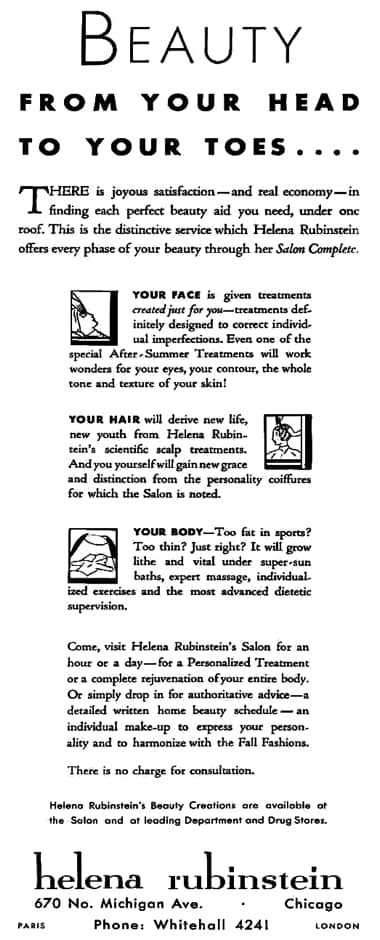
1931 Helena Rubinstein face, hair and body Treatments.
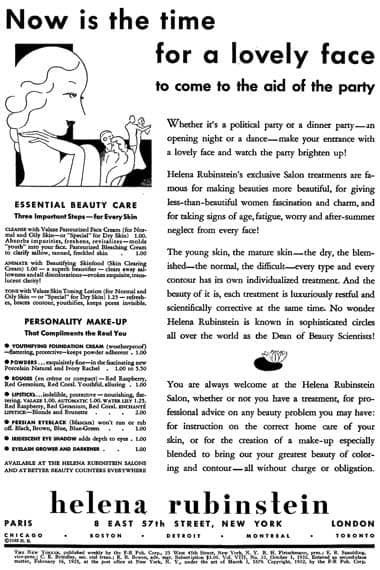
1932 Helena Rubinstein.
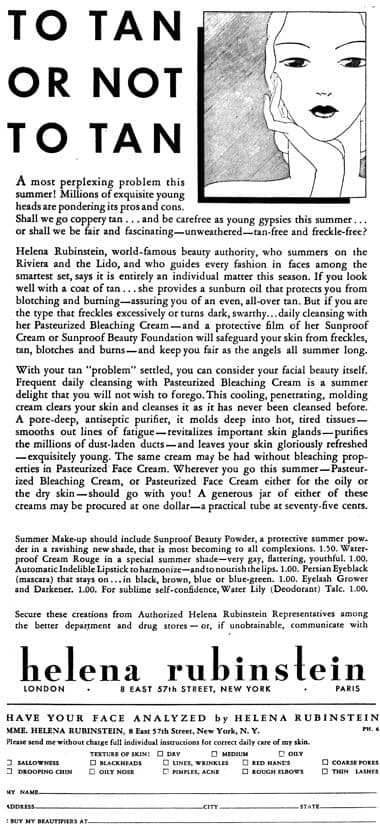
1932 Helena Rubinstein Summer Make-up.
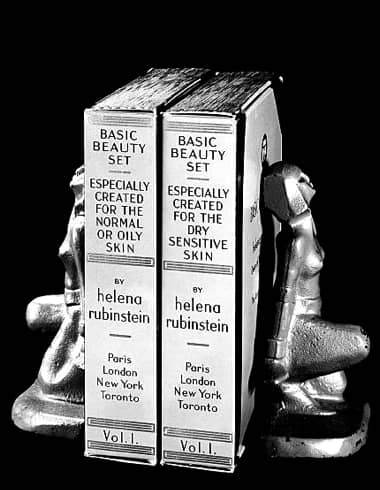
1932 Helena Rubinstein Beauty Sets.
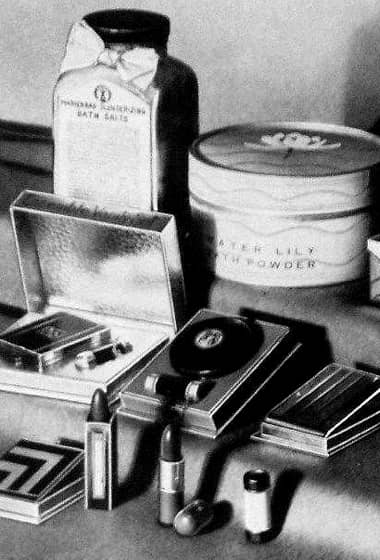
1932 Helena Rubinstein cosmetics.
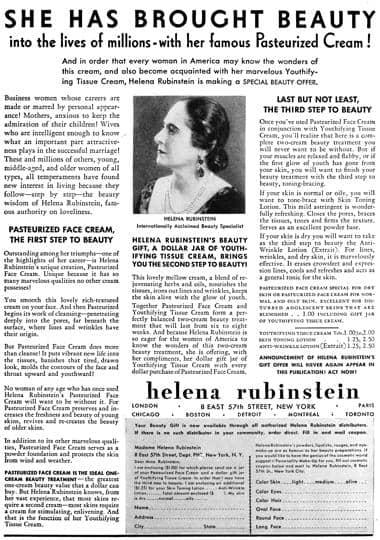
1933 Helena Rubinstein Pasteurized Face Cream.
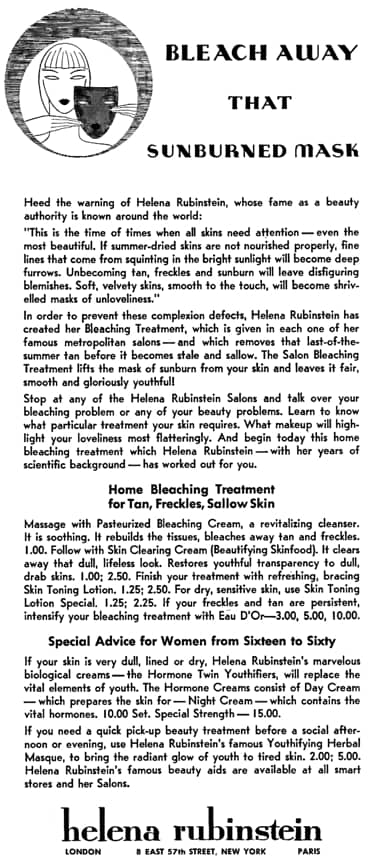
1933 Helena Rubinstein Home Bleaching Treatment.
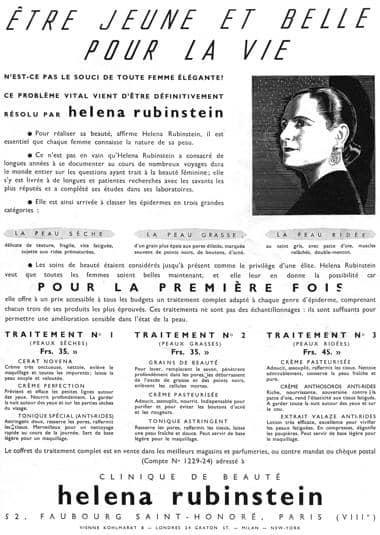
1934 Helena Rubinstein Clinique de Beauté.
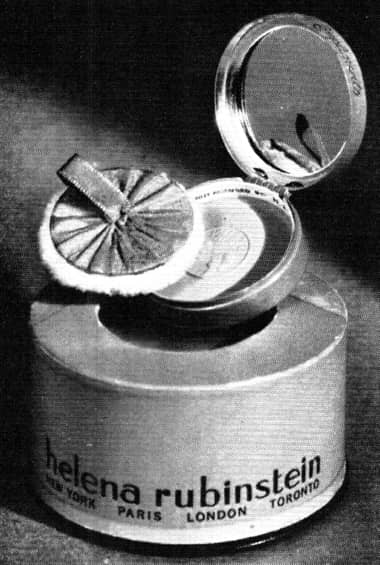
1934 Helena Rubinstein Ensemble Pack. Metal rouge container fits into an opening on the top of a powder box. the packages came in two colour combinations: green, silver and black for normal and oily skins; red, silver and black for dry skins.
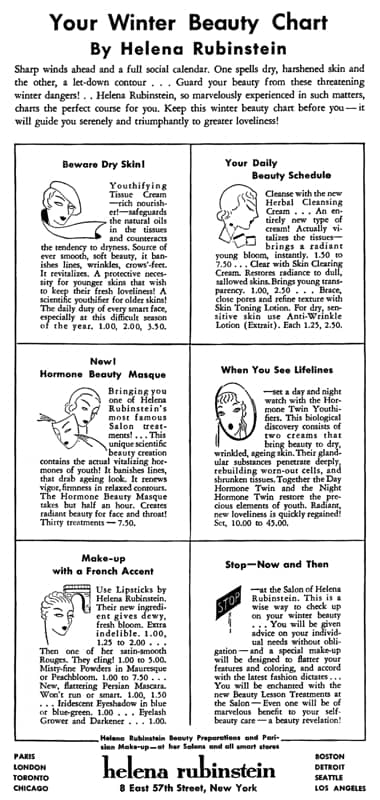
1934 Helena Rubinstein Winter Beauty Chart.
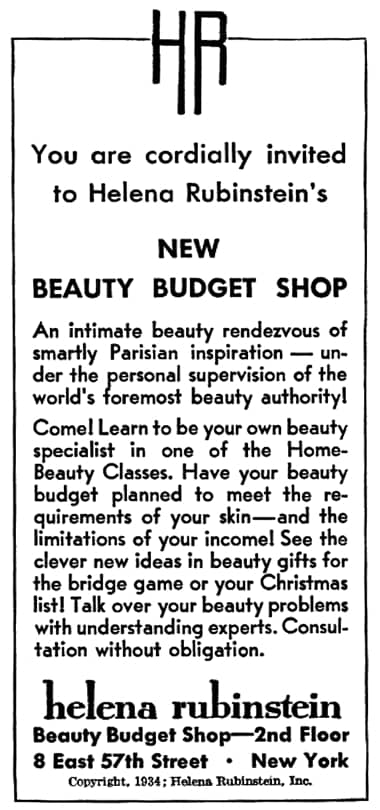
1934 Helena Rubinstein Beauty Budget Shop situated on the second floor of the the East 57th Street salon.
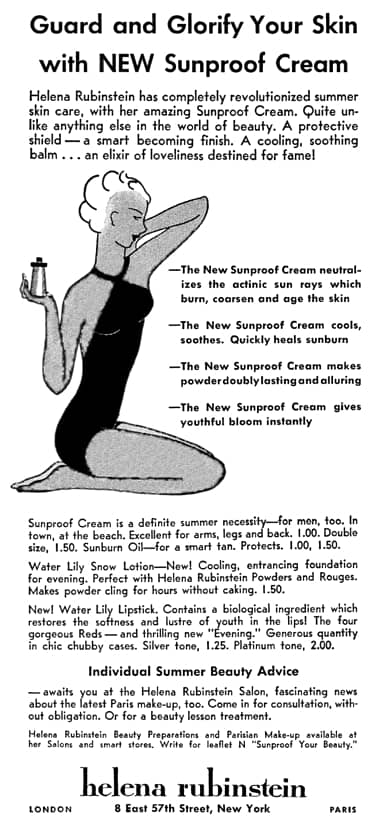
1934 Helena Rubinstein Sunproof Cream.
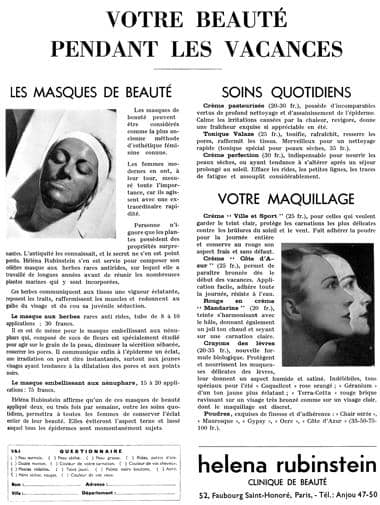
1935 Helena Rubinstein. Your beauty during the holidays.
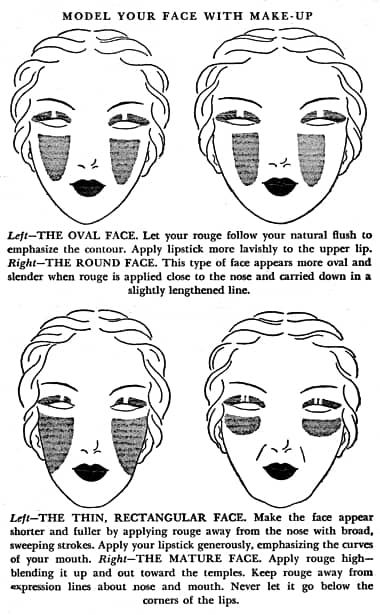
1936 Helena Rubinstein. Facial contouring with rouge (Rubinstein, 1936, p. 99).
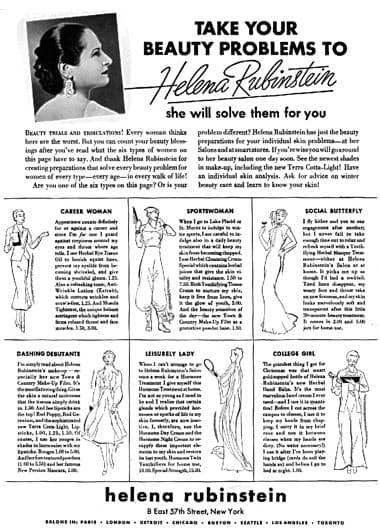
1936 Helena Rubinstein. Beauty problems.
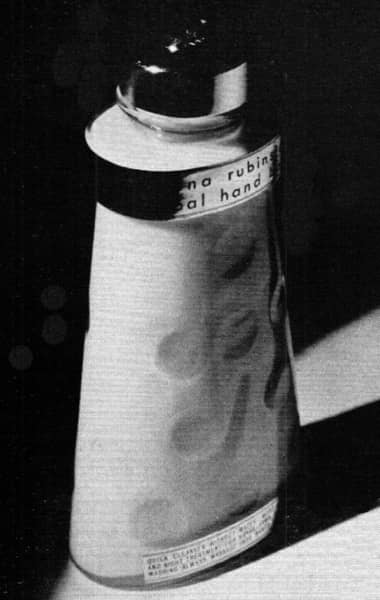
1936 Helena Rubinstein Herbal Hand Balm. The bottle was banded and capped in gold and had a scattering of dimples to facilitate holding.
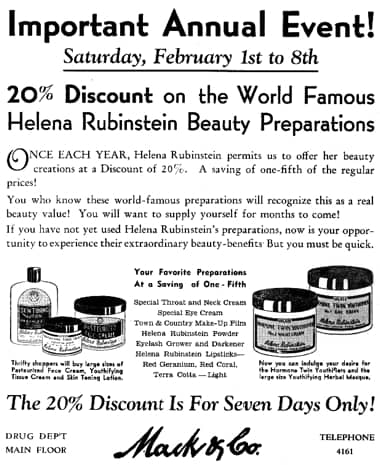
1936 Helena Rubinstein annual sale.
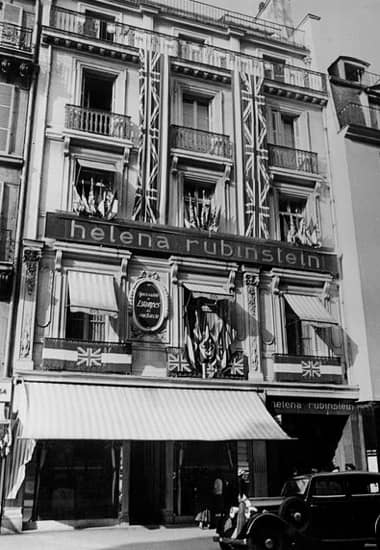
Helena Rubinstein Clinique de Beauté at 52 Rue du Faubourg Saint-Honoré decked out in British flags, possibly for the 1937 Coronation of George VI.
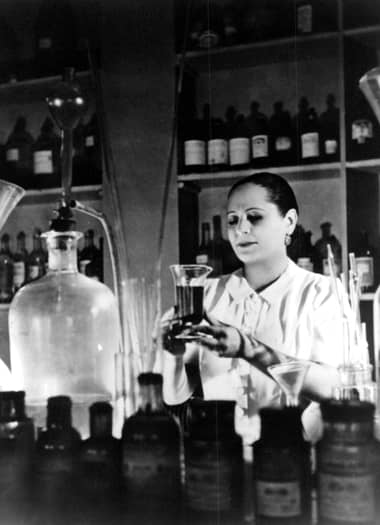
c.1937 Helena Rubinstein in her laboratory. Rubinstein had numerous photographs taken of her in the laboratory to promote the her image as ‘Beauty Scientist’.
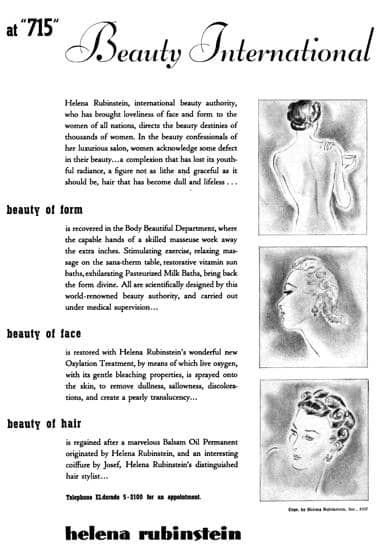
1937 Helena Rubinstein treatments at her salon at 715 Fifth Avenue, New York.
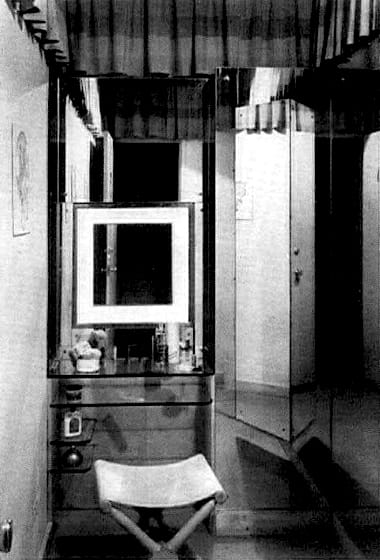
1937 Make-up station in the Helena Rubinstein salon at 715 Fifth Avenue, New York.
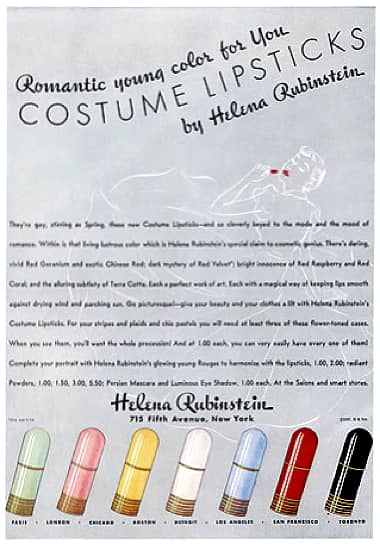
1937 Helena Rubinstein Costume Lipsticks in Gooseberry Green, Thistle Pink, Mimosa Yellow, Lotus White, Delphinium Blue, Carnation Red and Licorice Black cases.
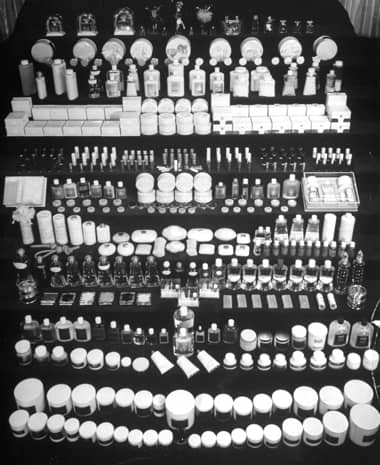
Above: 1937 The extensive product range of Helena Rubinstein.
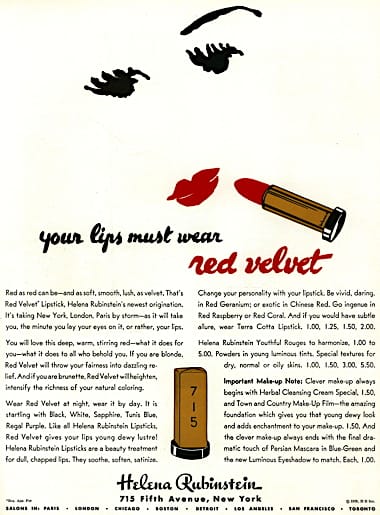
1937 Helena Rubinstein 715 lipstick developed to celebrate the opening of the new salon in New York.
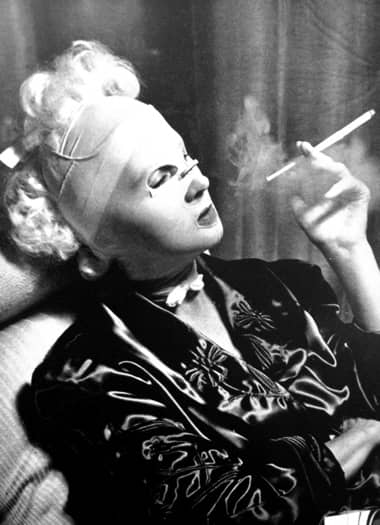
1938 Helena Rubinstein Beautilift Mask. Rubinstein recommended that it be used for twenty minutes once or twice a week.
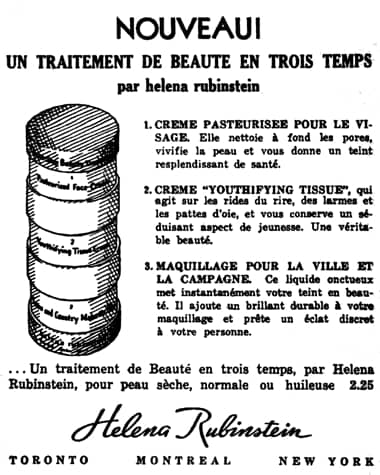
1938 Helena Rubinstein three step treatment pack: Pasteurised Face Cream, Youthifying Tissue Cream and Town and Country Make-up Film. This Canadian advertisement was still able to use the term ‘Tissue Cream’ something no longer possible in the United States after the passing of the FD&CA in 1938.
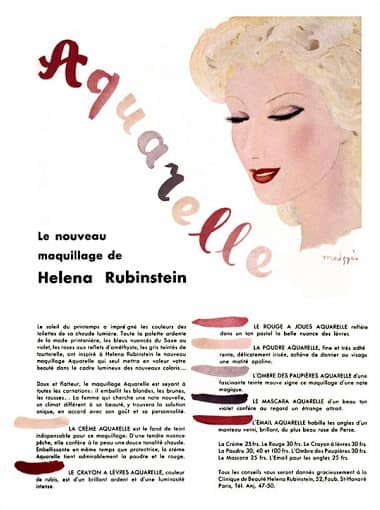
1938 Helena Rubinstein Aquarelle Make-up.
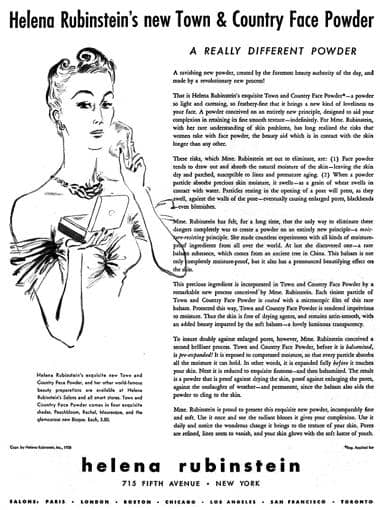
1938 Helena Rubinstein Town and Country Face Powder.
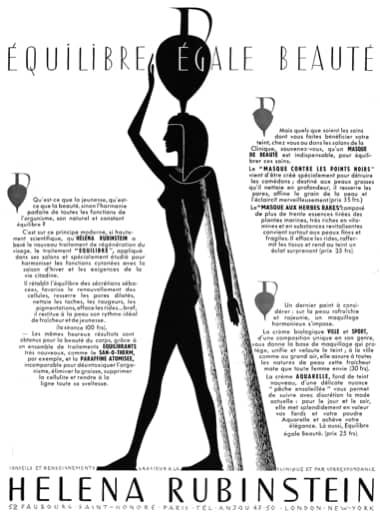
1938 Helena Rubinstein. Balance equals beauty.
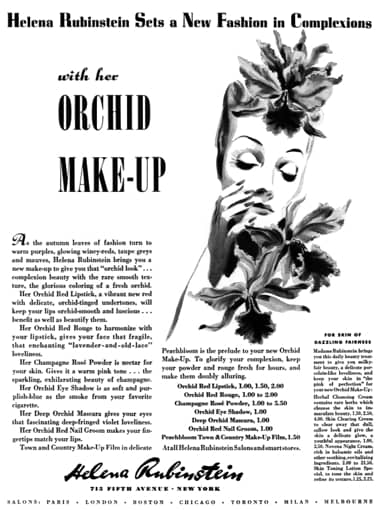
1938 Helena Rubinstein Orchid Make-up.
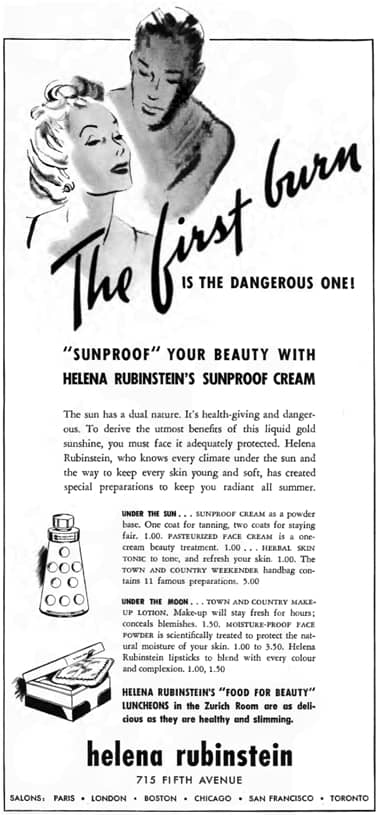
1939 Helena Rubinstein Sunproof Cream.
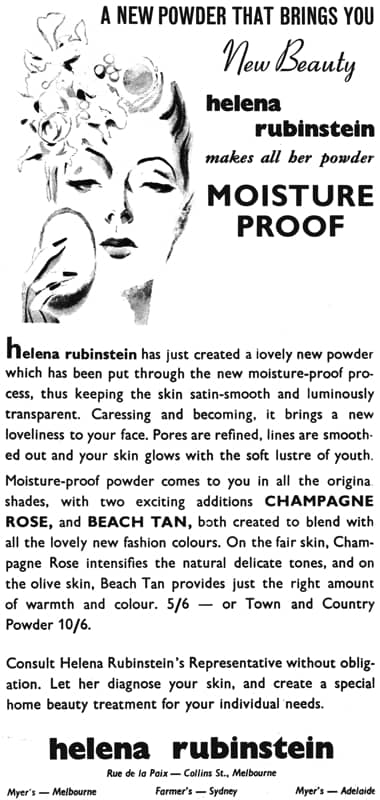
1939 Helena Rubinstein moisture proof powder.
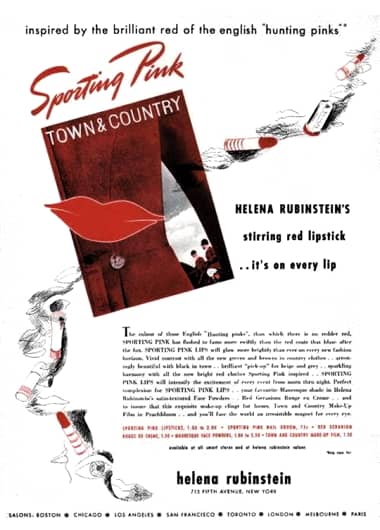
1939 Helena Rubinstein Sporting Pink.
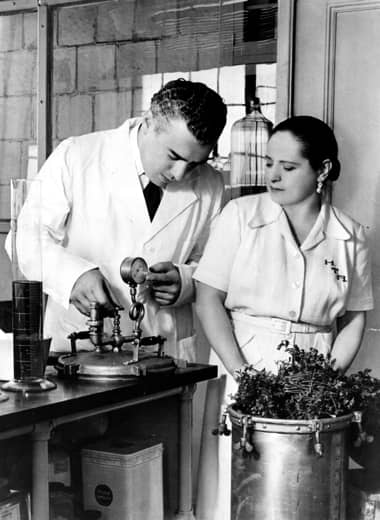
c.1939 Artchil Gourielli [1895-1955] and Helena Rubinstein in the laboratory.
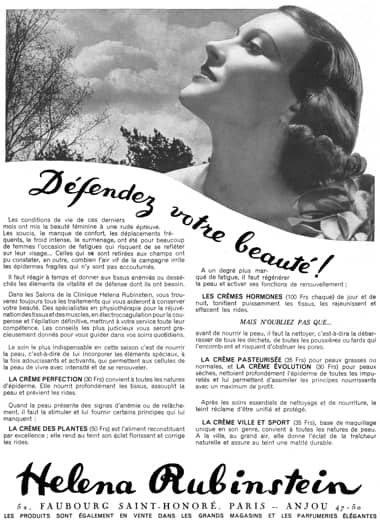
1940 Helena Rubinstein ‘Défendez votre beauté!’
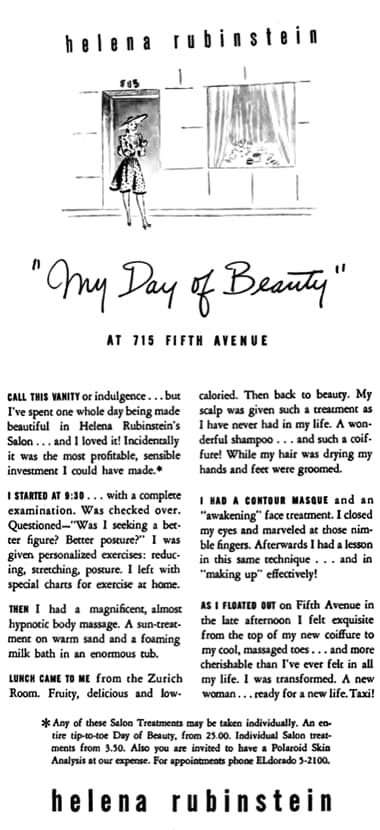
1940 Helena Rubinstein Day of Beauty.
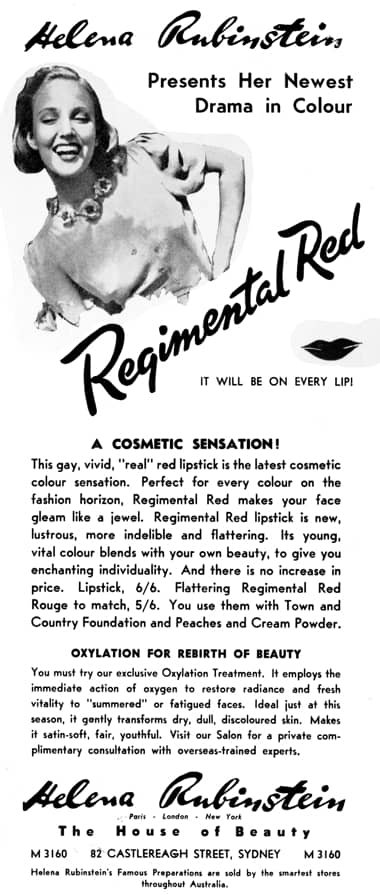
1940 Helena Rubinstein Regimental Red. The patriotic colour was released in Britain in 1939 and elsewhere in the Commonwealth later. The shade does not seem to have been available in the United States.
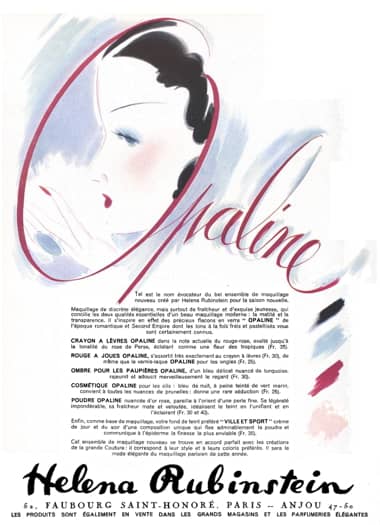
1940 Helena Rubinstein Opaline Make-up.
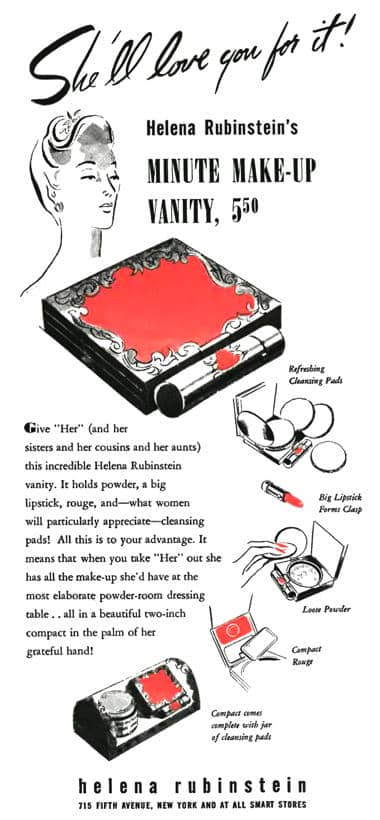
1940 Helena Rubinstein Minute Make-up Vanity. Introduced in 1939, these compacts got their name from the Minute Make-up Pads included with the vanity. The pads removed grime and old make-up while, at the same time, applying a thin film of Town and Country Make-up Lotion as a foundation.
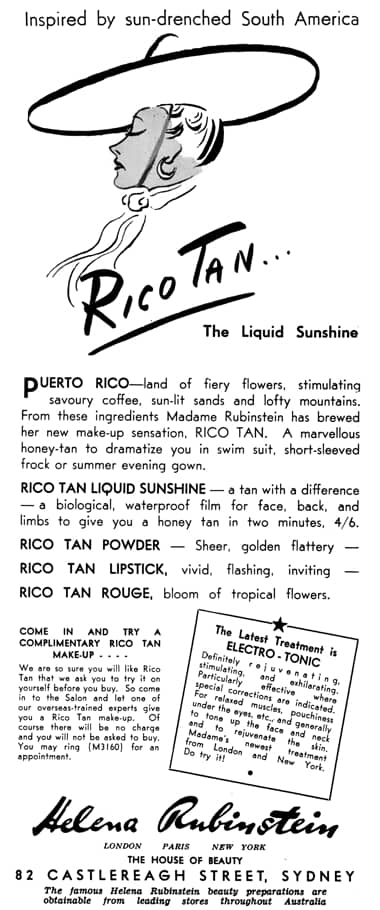
1940 Helena Rubinstein Rico Tan (Australia). In the United States the Rico Tan range consisted of Rico Red Lipstick, Rico Tan Town and Country Make-up Film, Rico Tan Powder, Rico Red Nail Groom, Rico Red Rouge, Jade Eyeshadow and Brown Mascara.
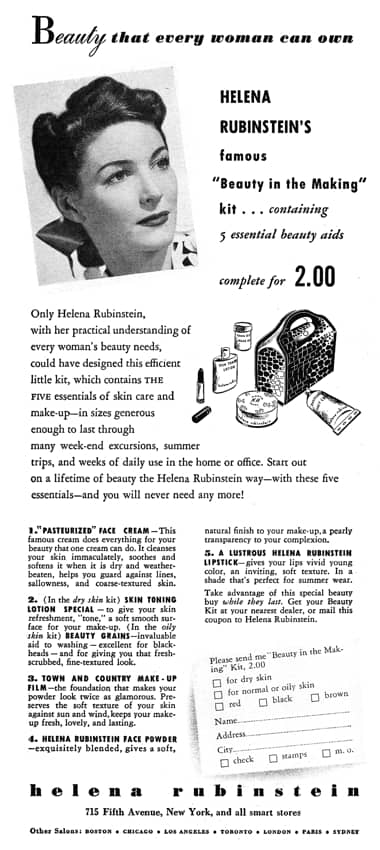
1940 Helena Rubinstein Beauty Kit.
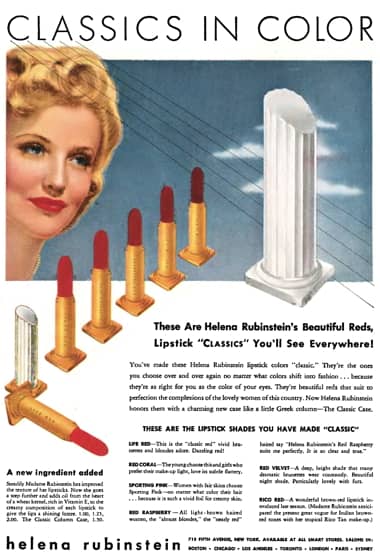
1940 Helena Rubinstein Lipstick Classics. Shades: Life Red, Red Coral, Sporting Pink, Red Raspberry, Red Velvet and Rico Red.
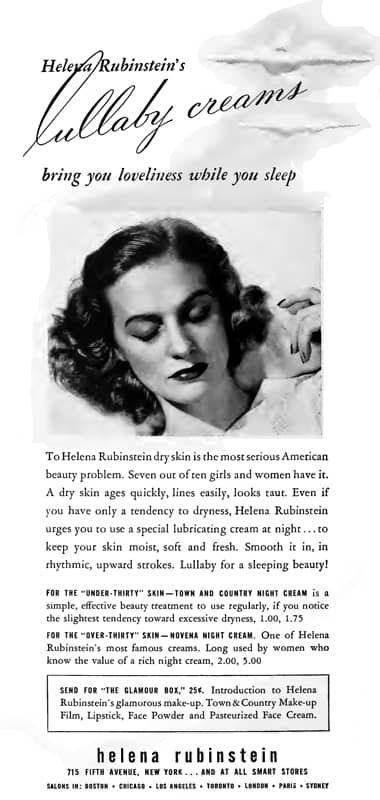
1941 Helena Rubinstein Town and Country Night Cream and Novena Night Cream.
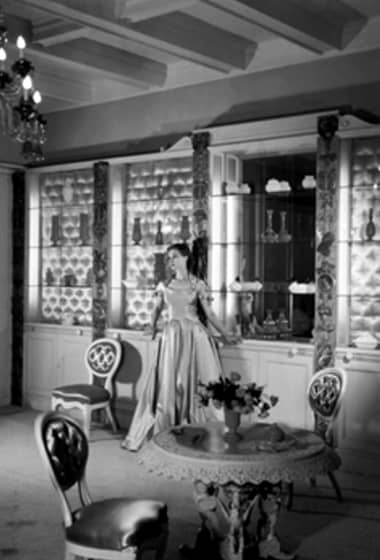
1941 Giftroom in the Gourielli Building.
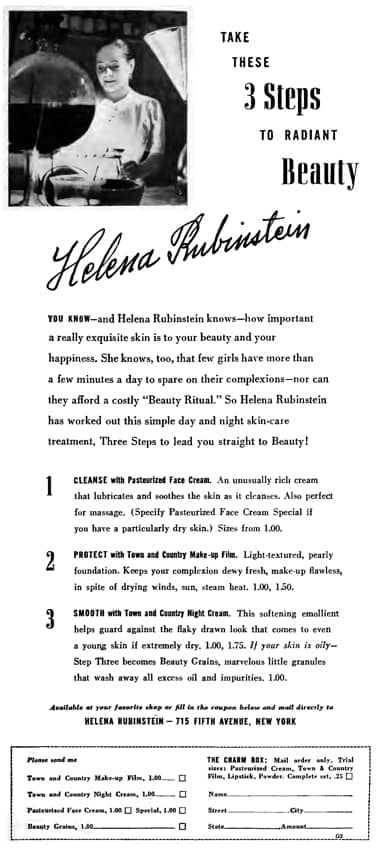
1941 Helena Rubinstein Three Steps to Beauty.
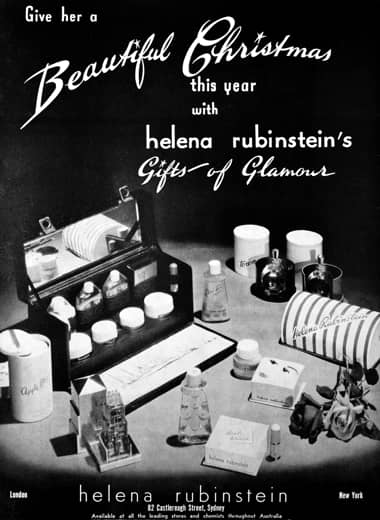
1941 Helena Rubinstein Christmas Gifts.
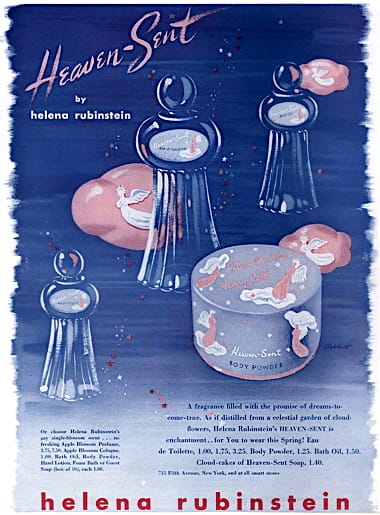
1942 Helena Rubinstein Heaven-Sent.
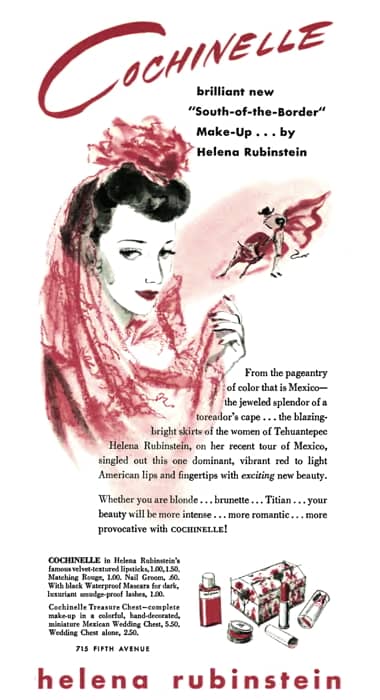
1942 Helena Rubinstein Cochinelle.
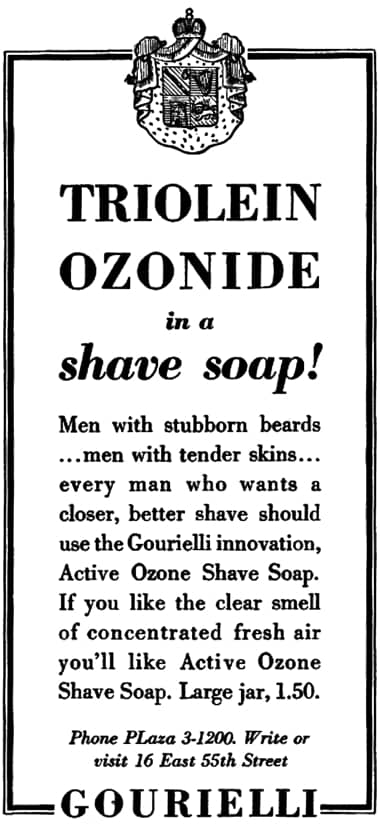
1942 Gourielli Shaving Soap with Triolein Ozonide.
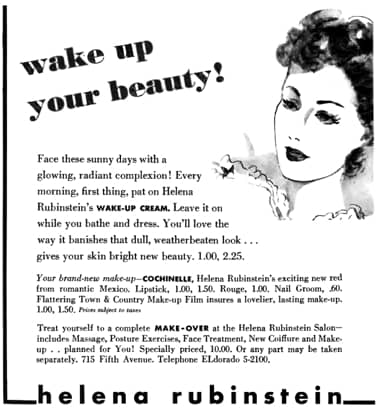
1942 Helena Rubinstein Wake-up Cream. The renamed Beautifying Skinfood.
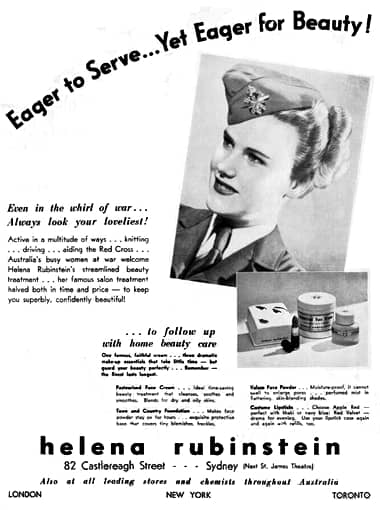
1942 Helena Rubinstein Valaze Face Powder, Costume Lipstick, Pasteurised Face Cream and Town and Country Foundation.
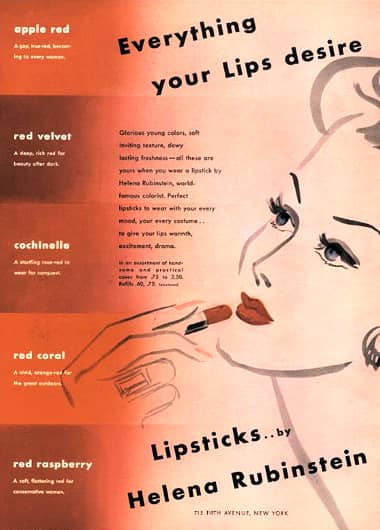
1942 Helena Rubinstein Lipsticks in Apple Red, Red Velvet, Cochinelle, Red Coral and Red Raspberry shades.
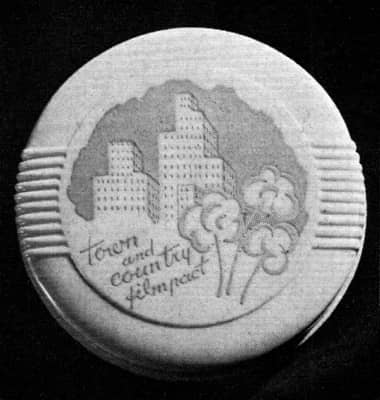
1942 Helena Rubinstein Filmpact.
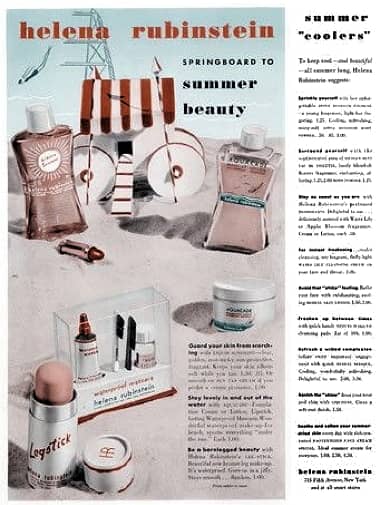
1942 Helena Rubinstein water-resistant and sun-protective cosmetics.
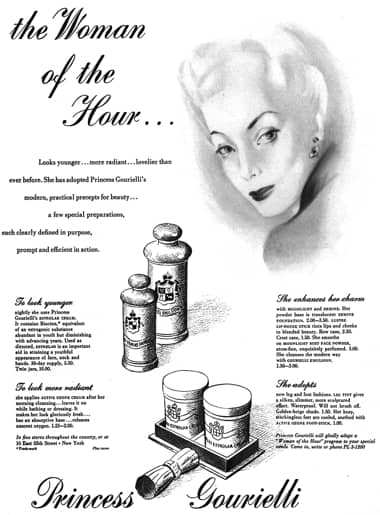
1943 Princess Gourielli.
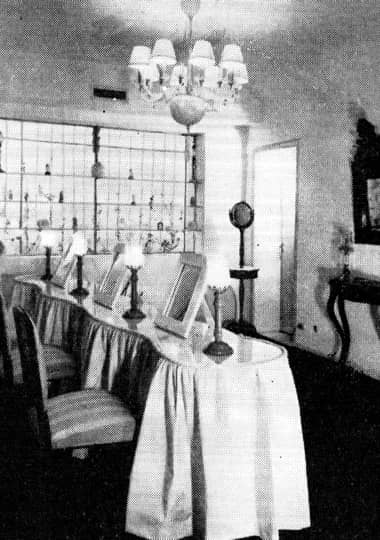
1944 Make-up Bar in the Helena Rubinstein salon in Buenos Aires.
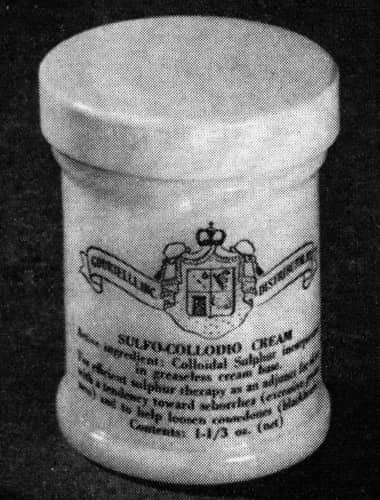
1944 Gourielli Sulfo-Colloidal Cream. Gourielli products were packaged in blue-labelled, white porcelain jars.
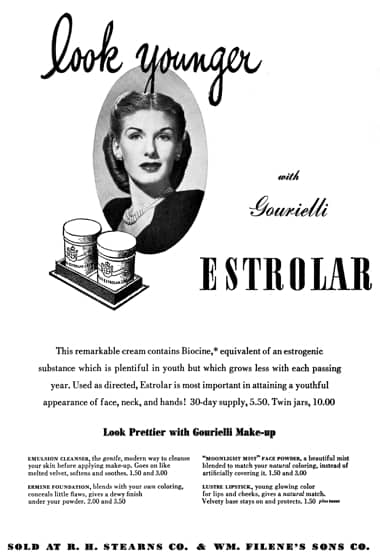
1944 Gourielli Estrolar with Biocene.
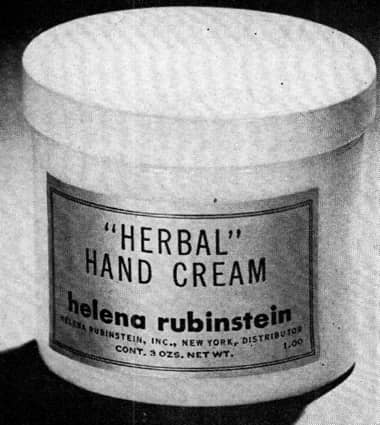
1945 Helena Rubinstein Herbal Hand Cream.
